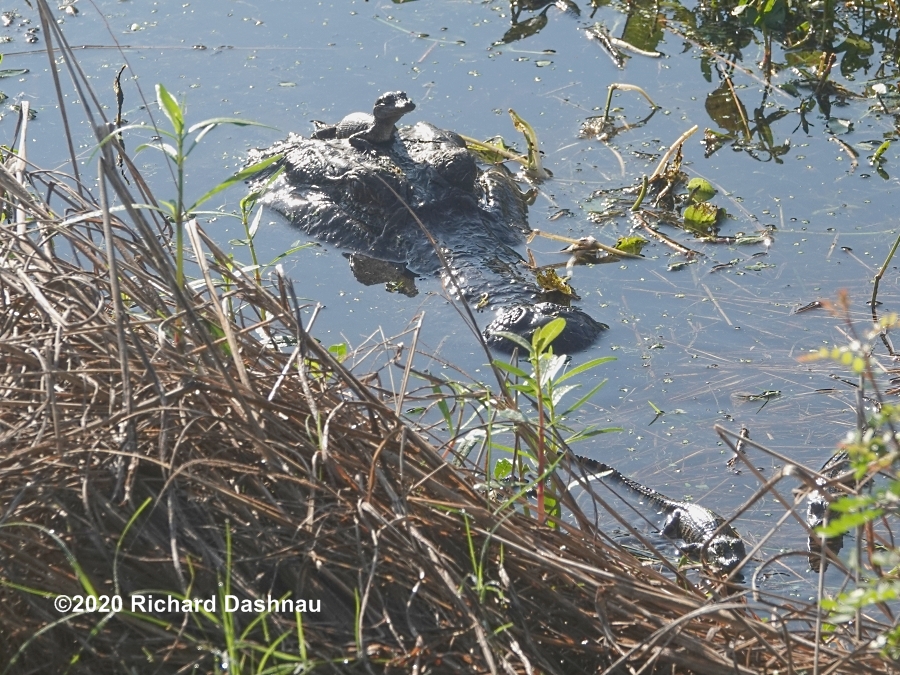
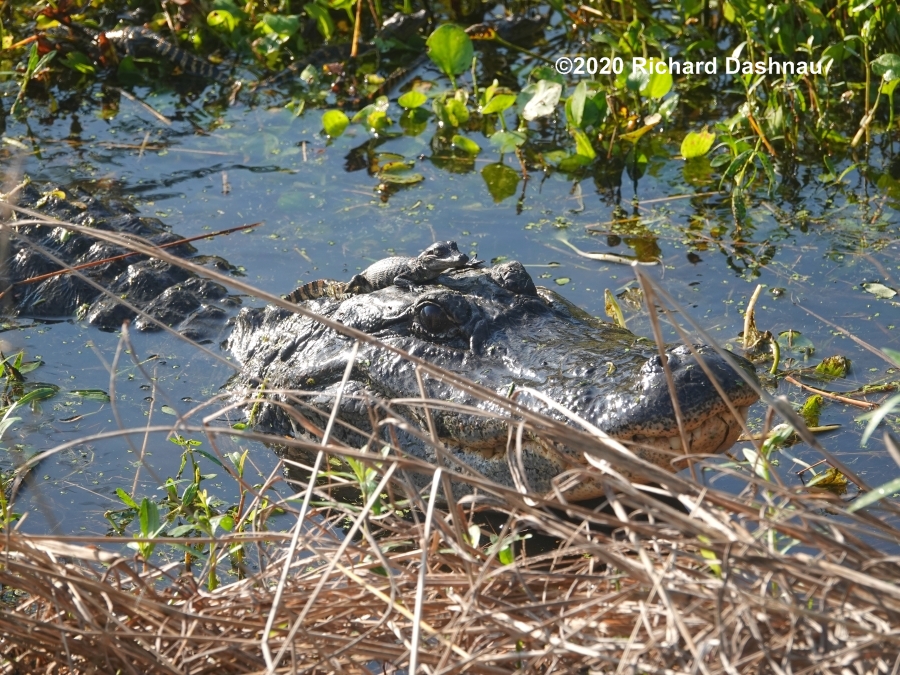
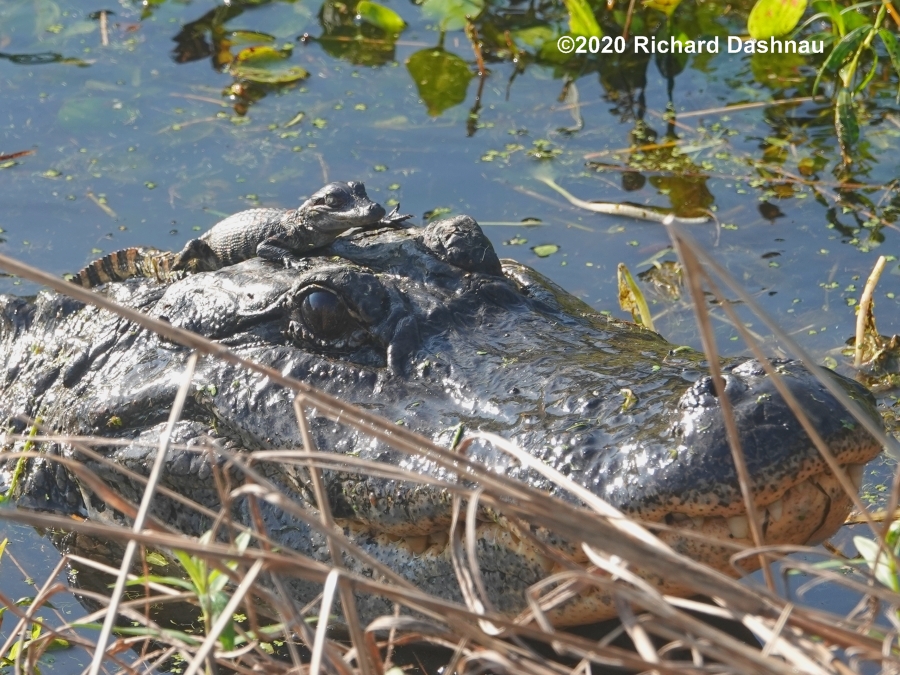
update 10/05/2020
(material filmed Sept 27,
2020) Today
I went out to Brazos Bend State Park. I had visited very briefly the
week before, but
today I spent more time on the trails.
As a volunteer, I may
interact with park visitors. I wore my mask the entire time I
was
there, even though I was out on the trails. Most of
the visitors did, too.
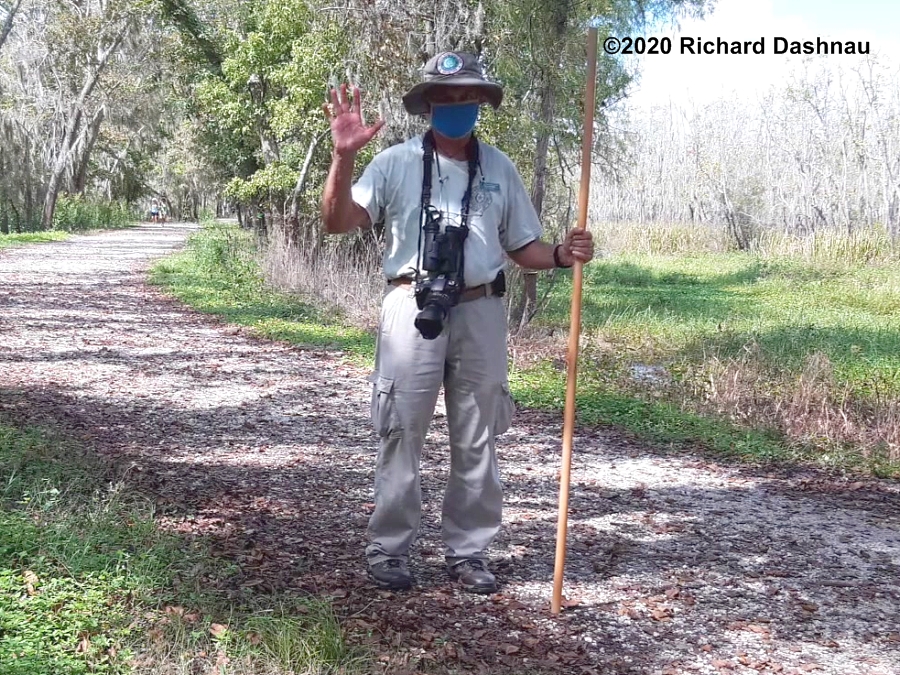
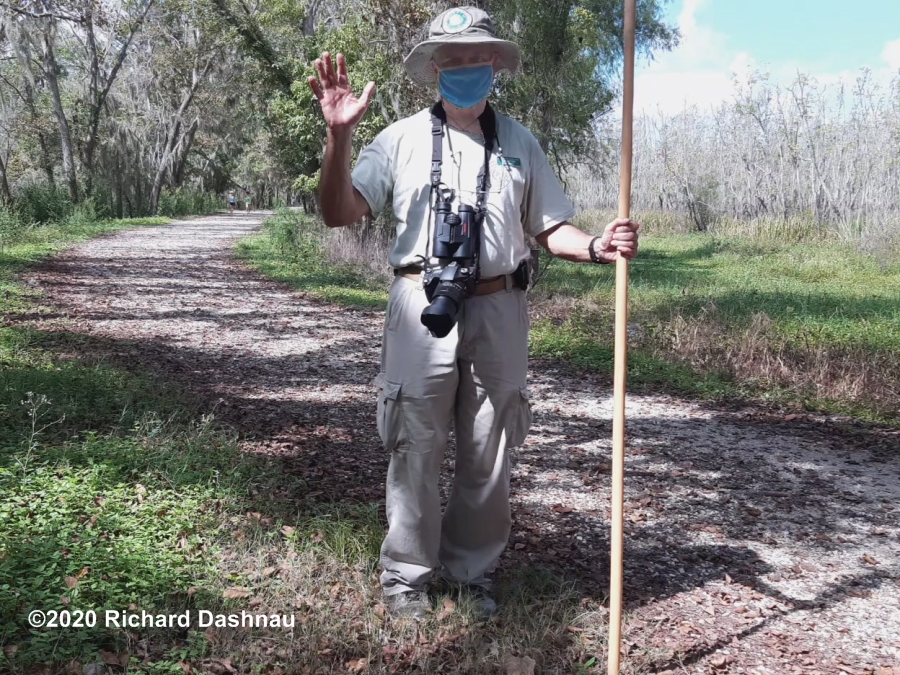
It
was good to be out at the park! At about 9am I saw a mother
alligator with a pod of babies. The light of the morning sun
was
harsh, and tried to get some pictures
of the babies on their mother.
While
I had the camera focused on the mother's head, she started lifting her
snout. Such movements are often the start of some kind of social
signal, such as a head slap, gape, or bellow.
I started
shooting video, and she started bellowing! When she started,
one
of the babies had been on her head (as in the pictures above), but it
got off quickly. The images below are
frames from
the video clip. The video also shows that I was
pretty far away from her.
The
alligator stopped bellowing after one "bout" (a series of bellows in
succession--usually about 6). She didn't bellow again, but
other
alligators answered from somewhere in Pilant lake, and
further
along in Forty Acre Lake. I don't know why she started
bellowing
(and she might not have been the first one that bellowed--I just hadn't
noticed). Most alligator bellowing happens
during
mating/courtship season (March - May); but alligators do bellow at
other times. I haven't found anything that describes why they
might bellow. It seems that sometimes they bellow
when the
temperature changes (like when a cold or warm front comes through).
Someone guessed that alligators might be "claiming" their
territories for the winter. I left the mother and pod
to look for the other bellowing gators. About
3 hours later, I returned to this pod. She didn't bellow
again,
but I watched as the babies foraged around her--and on her for a while.
I filmed
more video, and it is included in the same
video clip. The images below are photos taken separately from
the video.
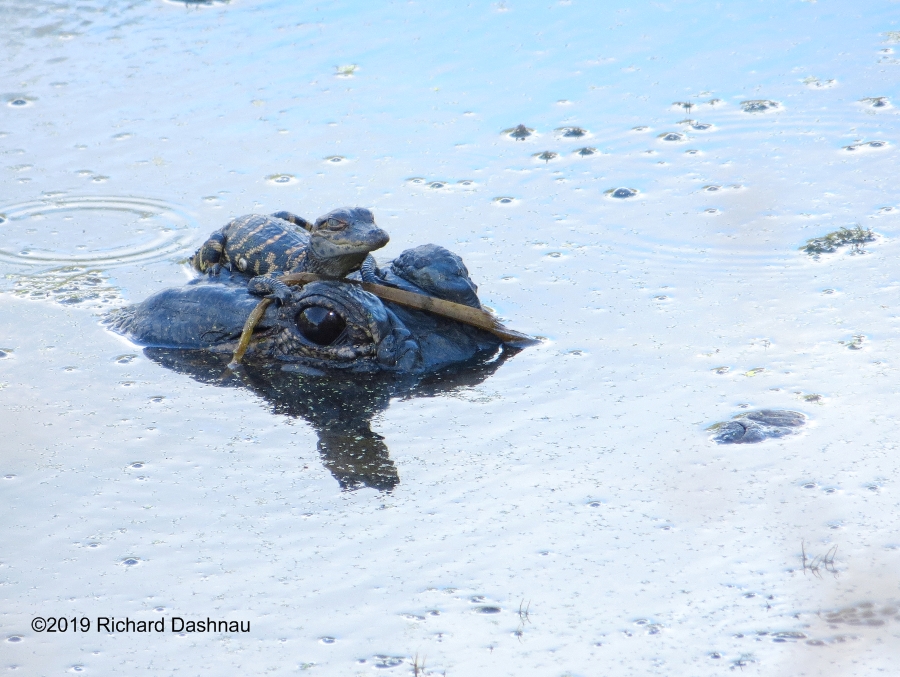
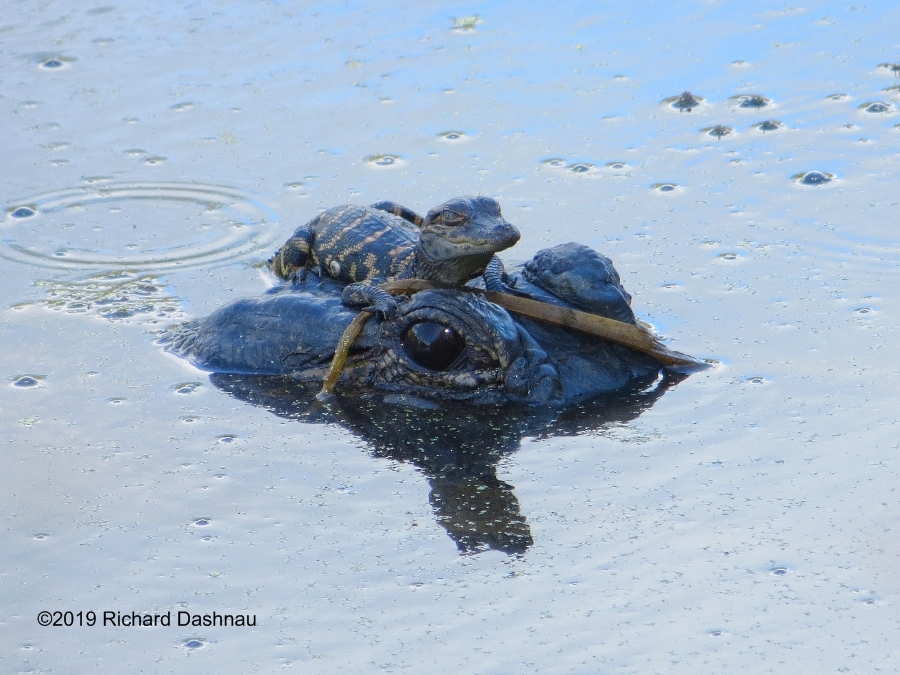
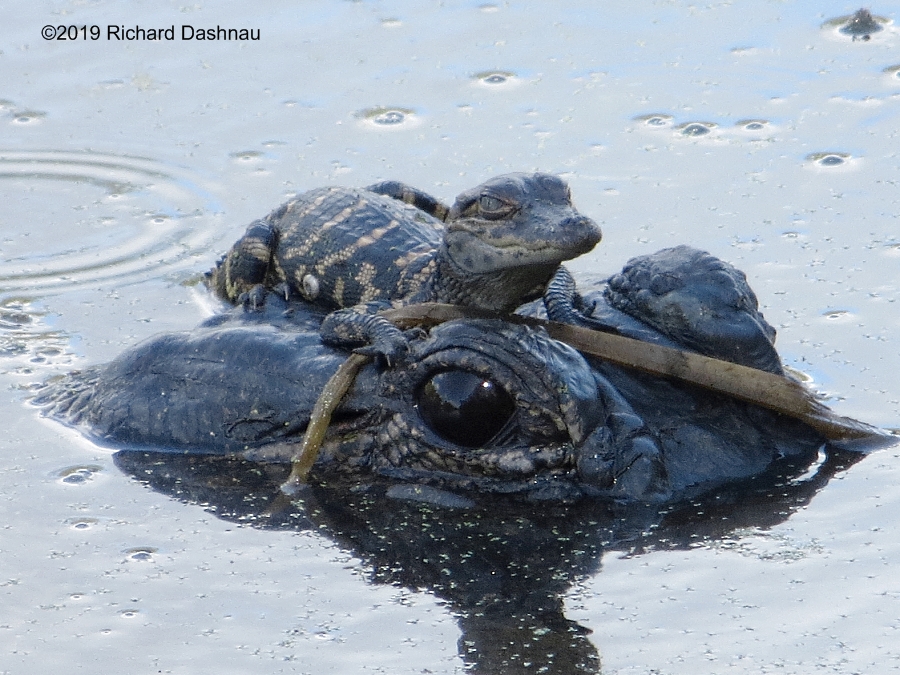
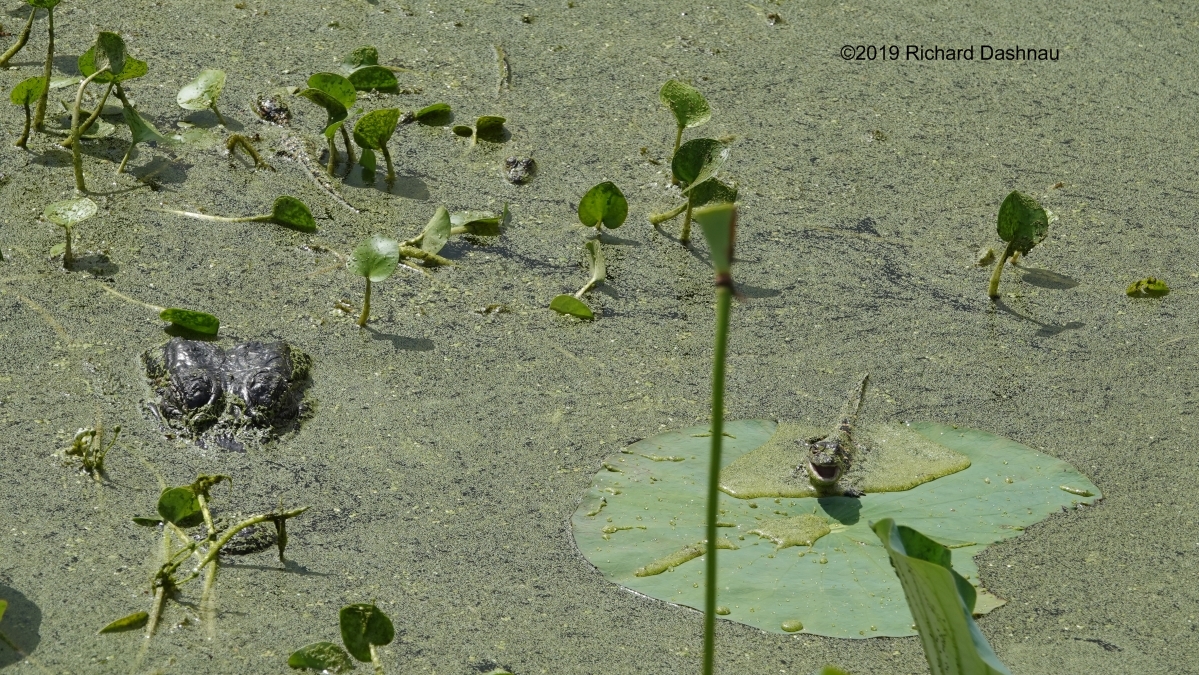
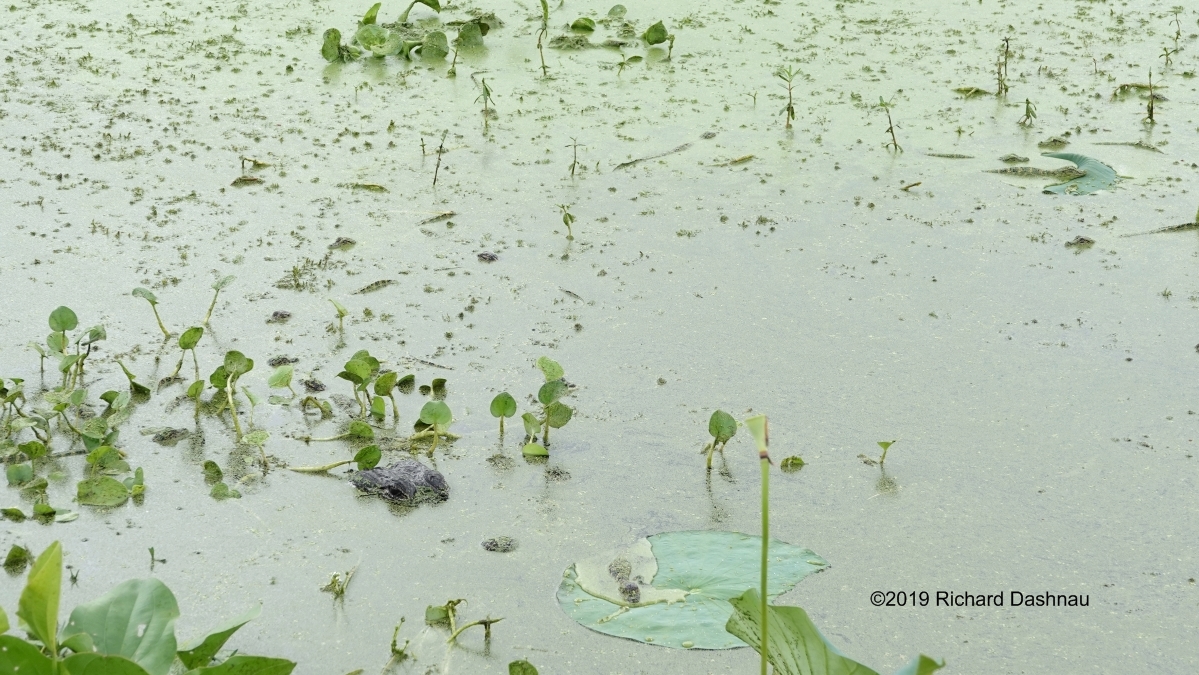
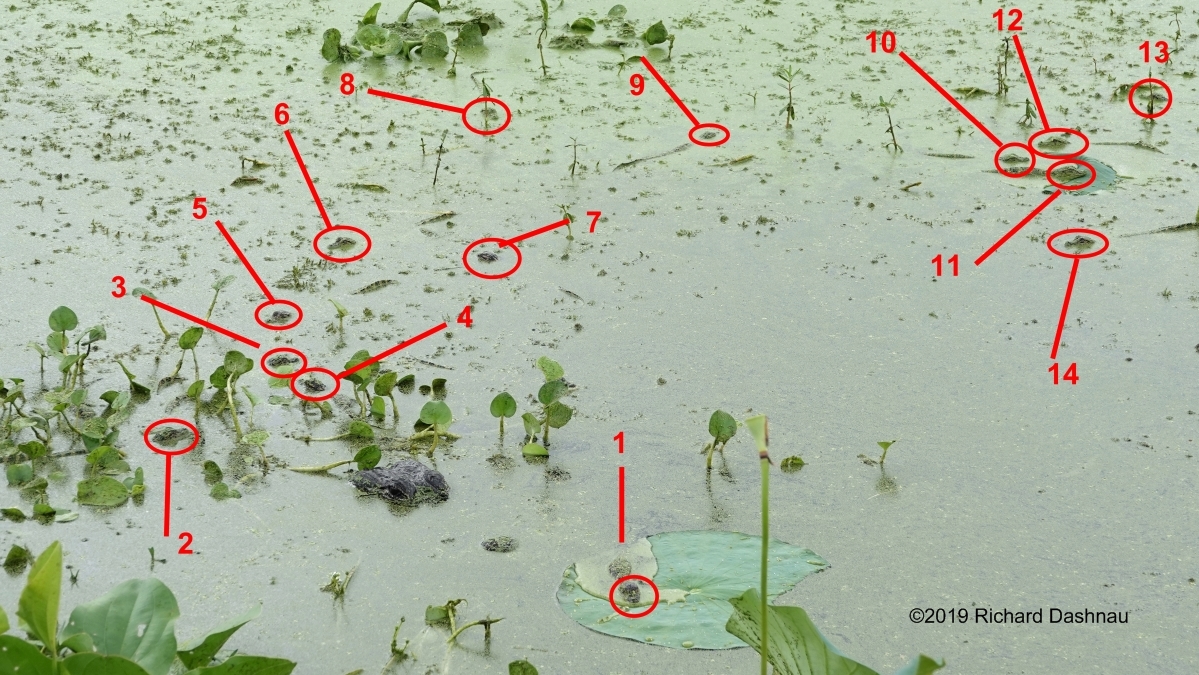
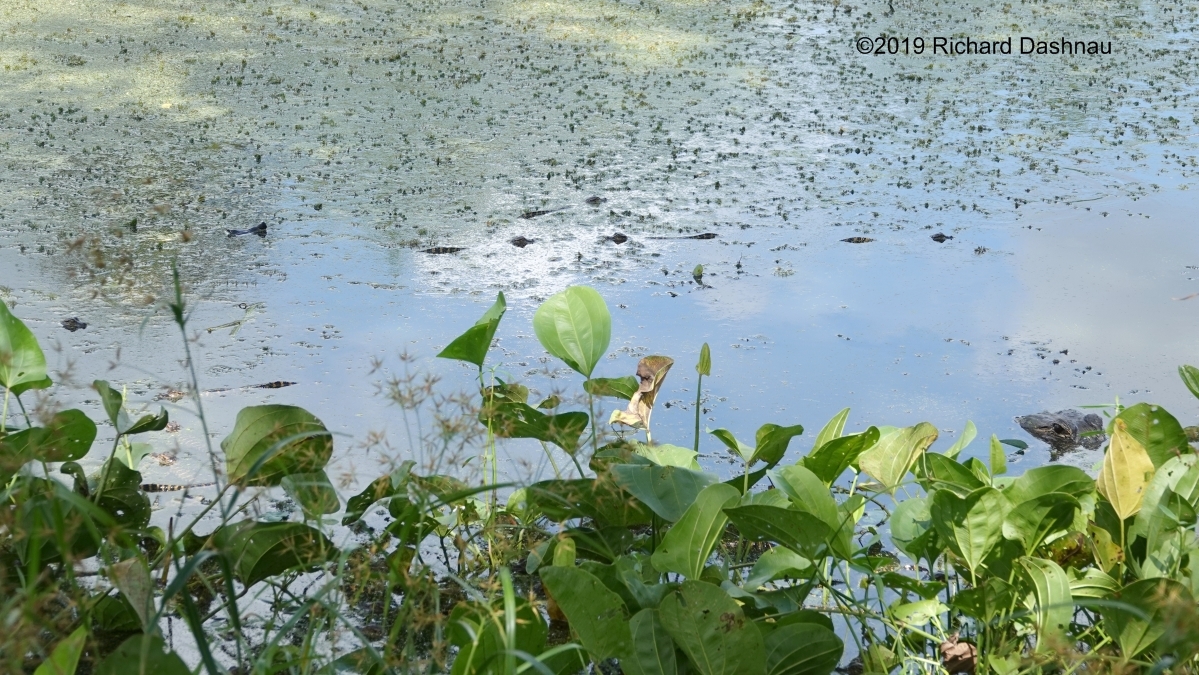
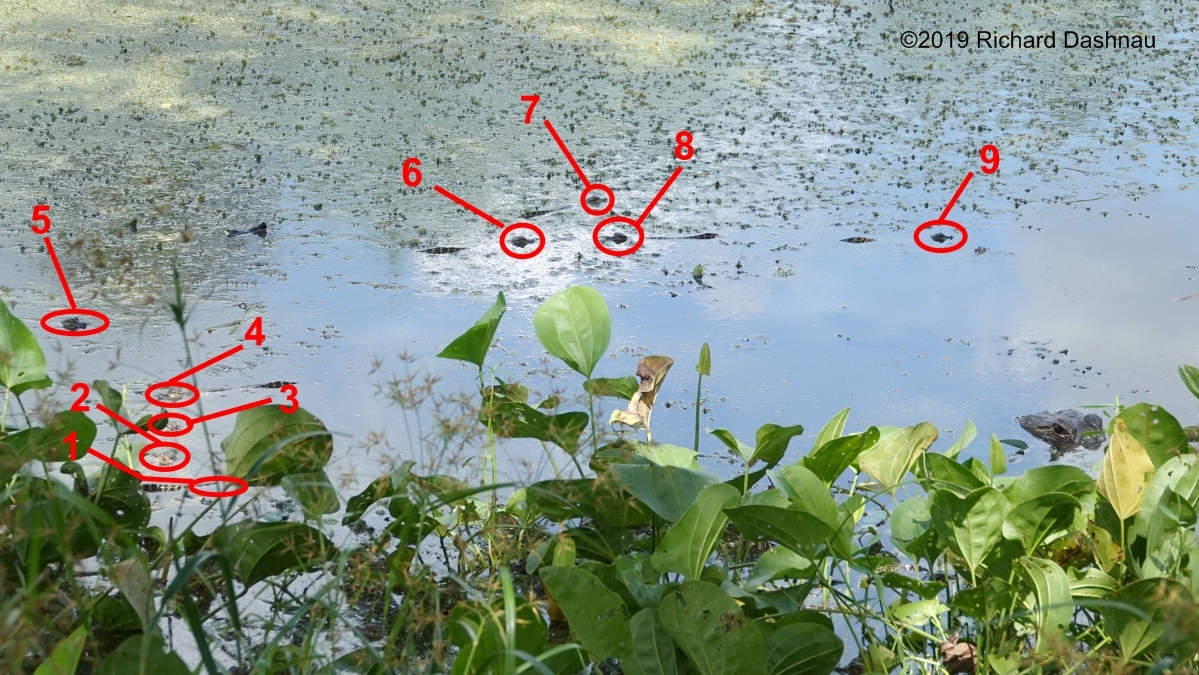
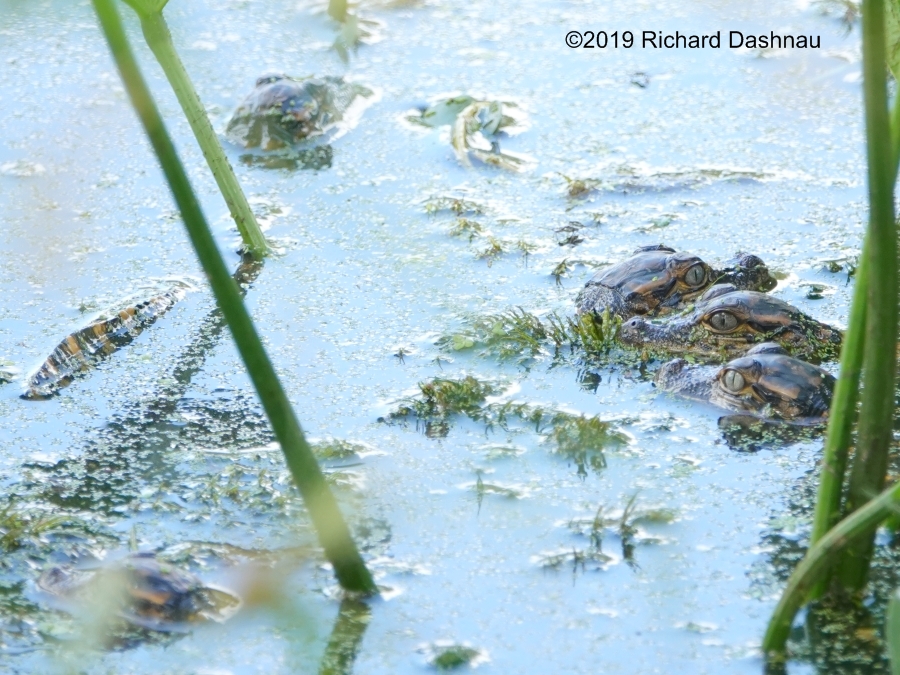
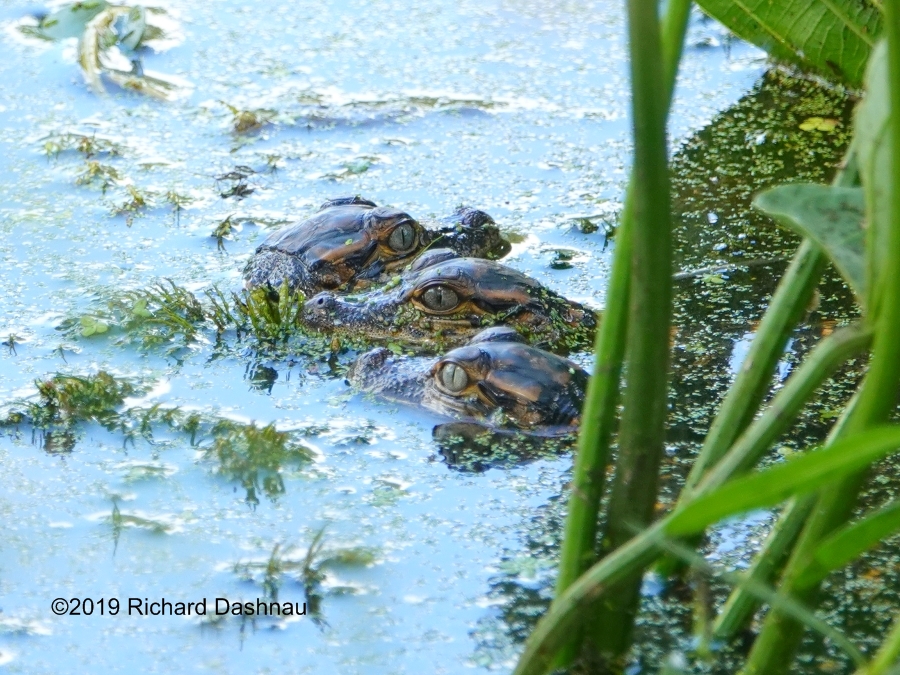
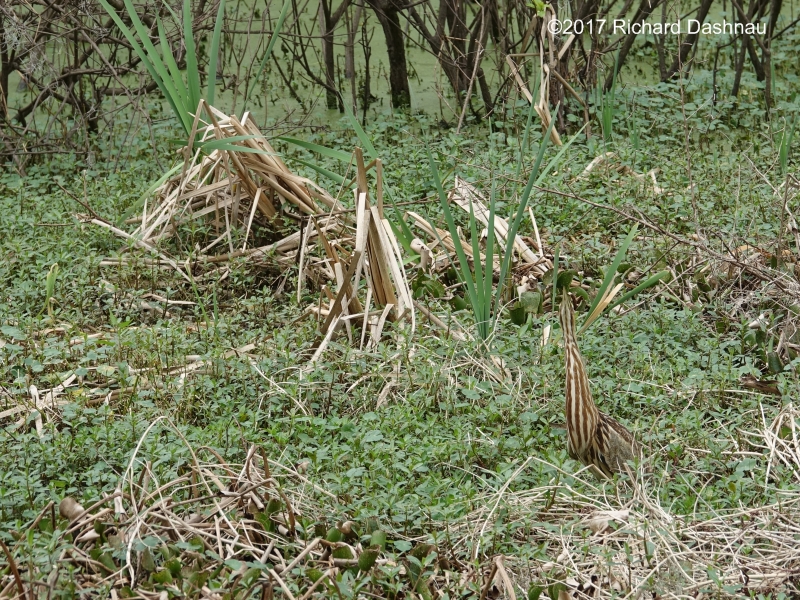
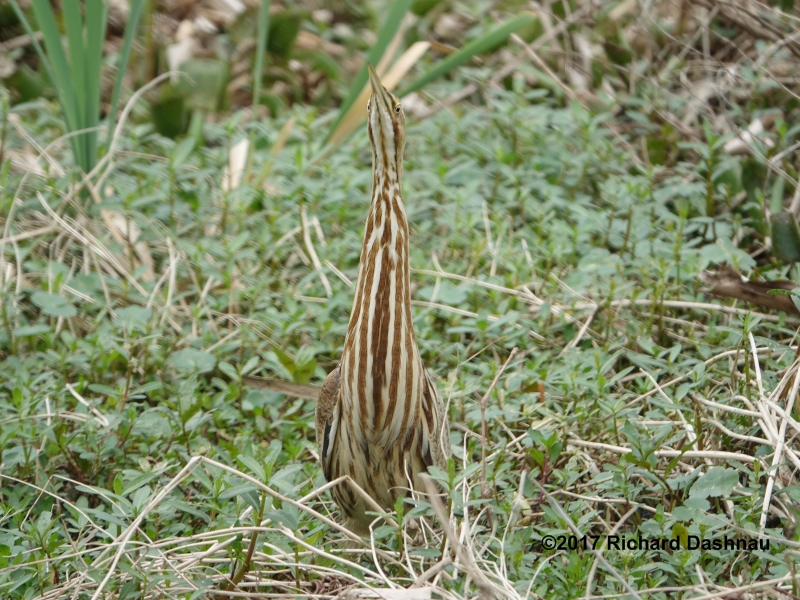
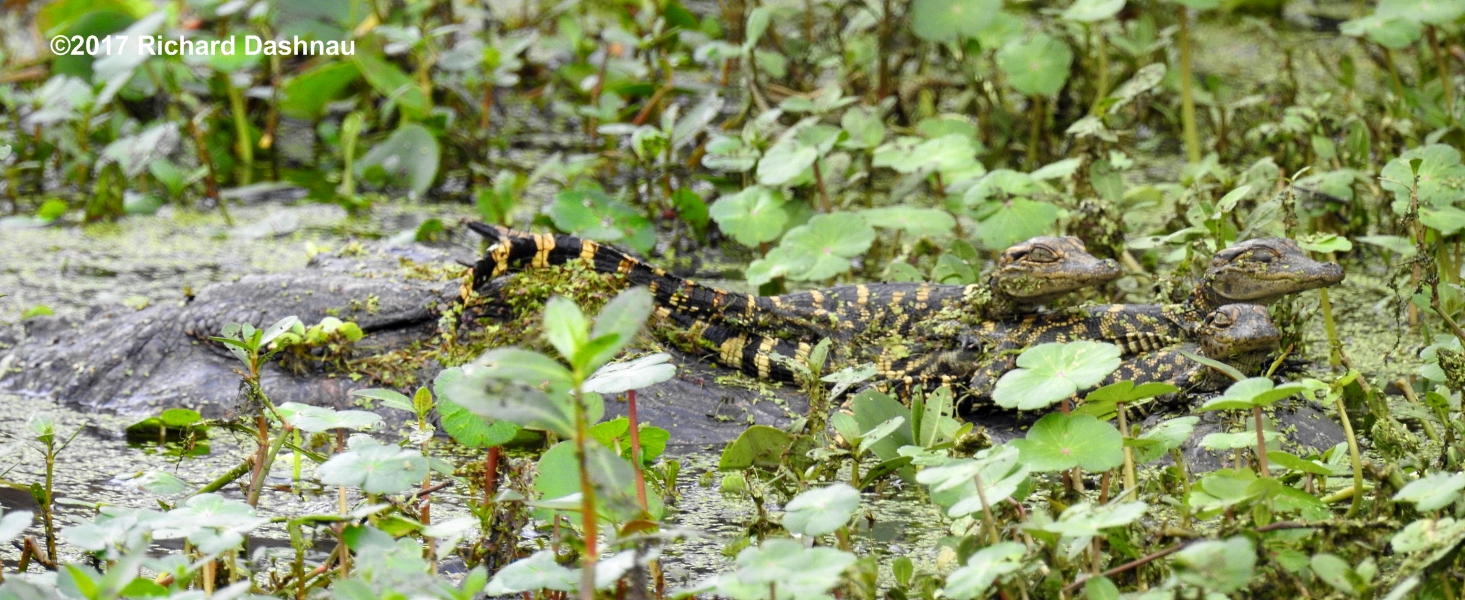
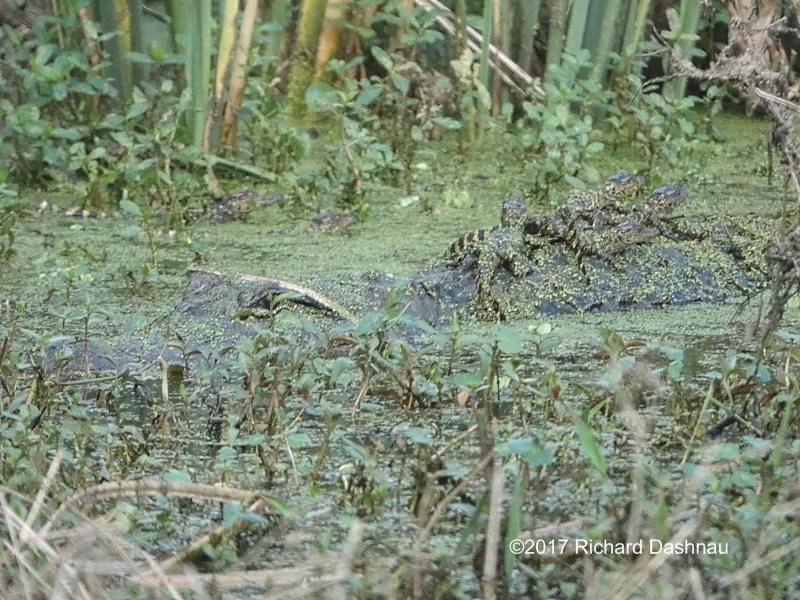
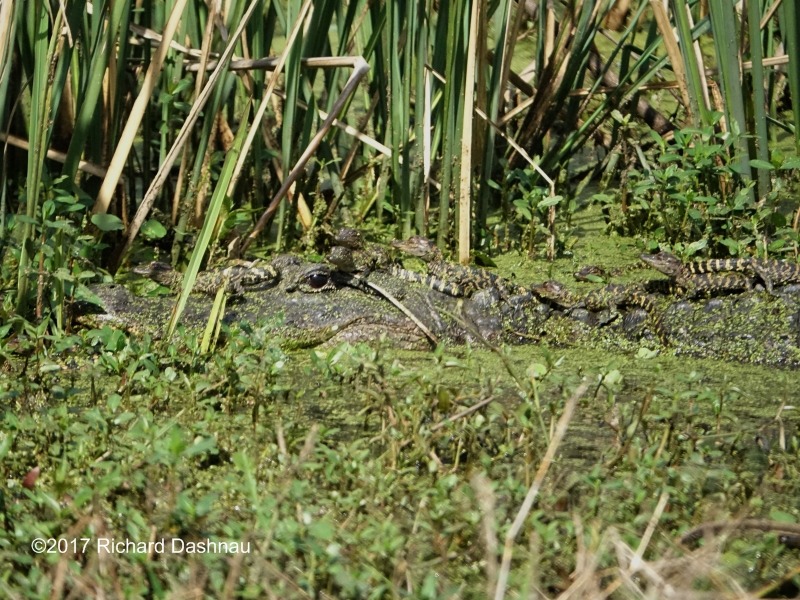
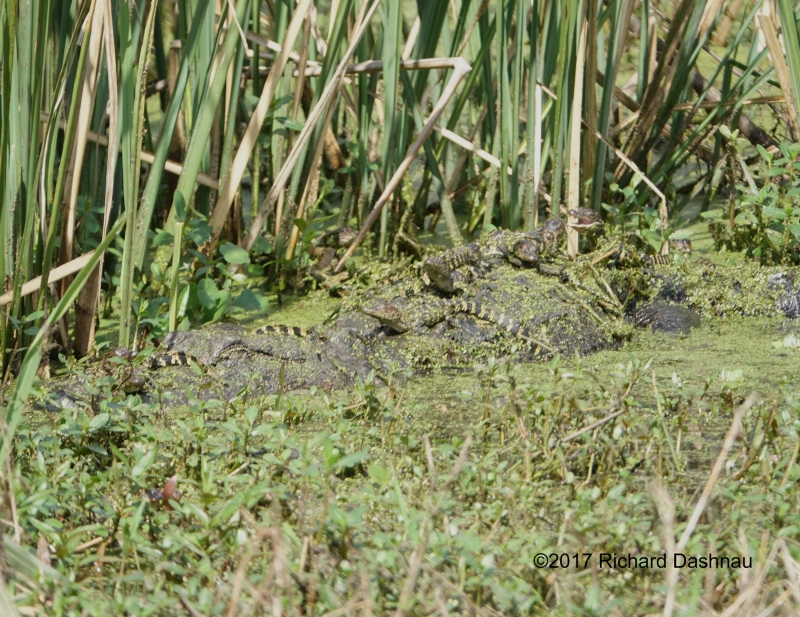
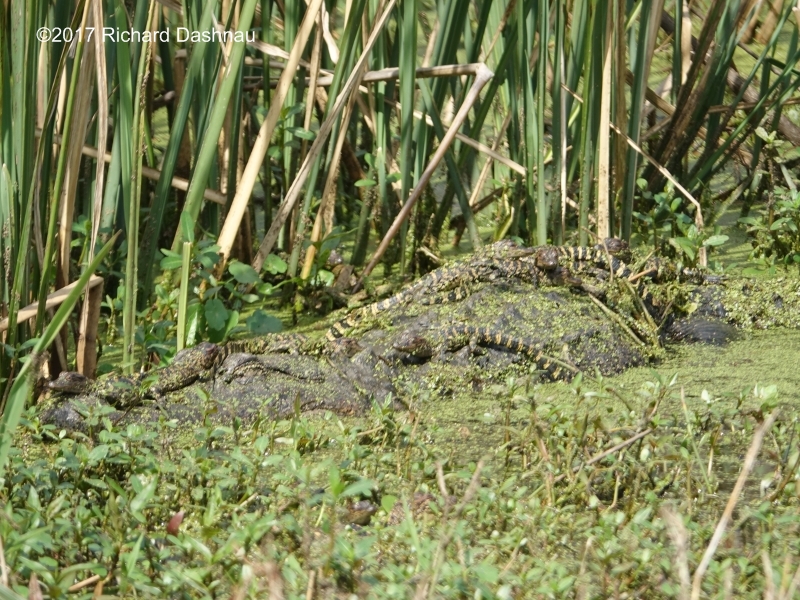
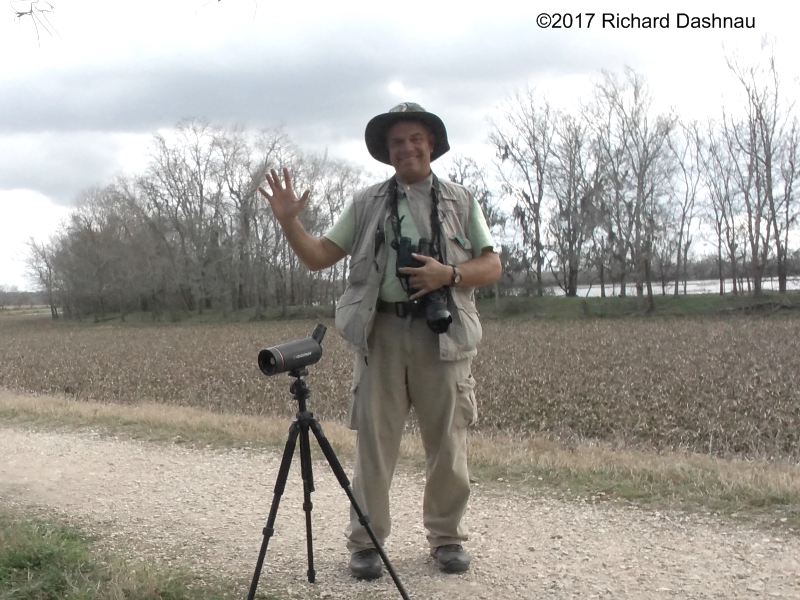
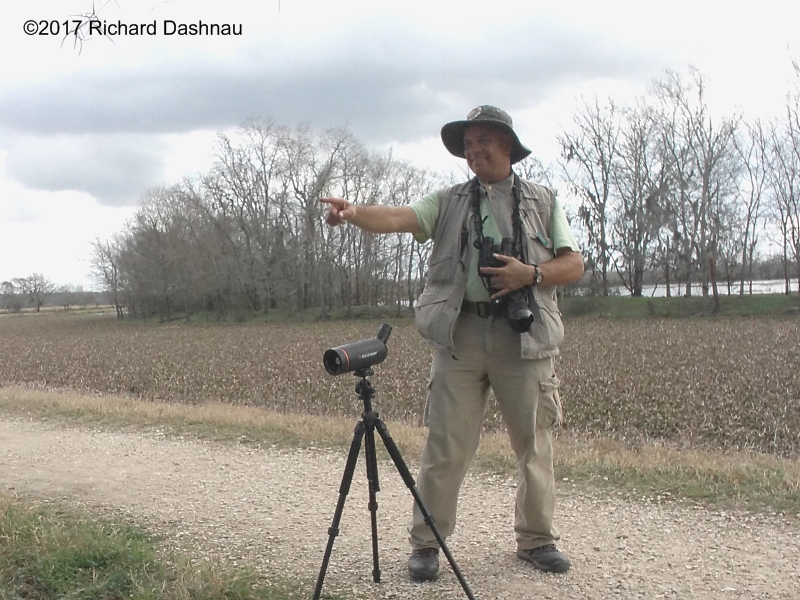
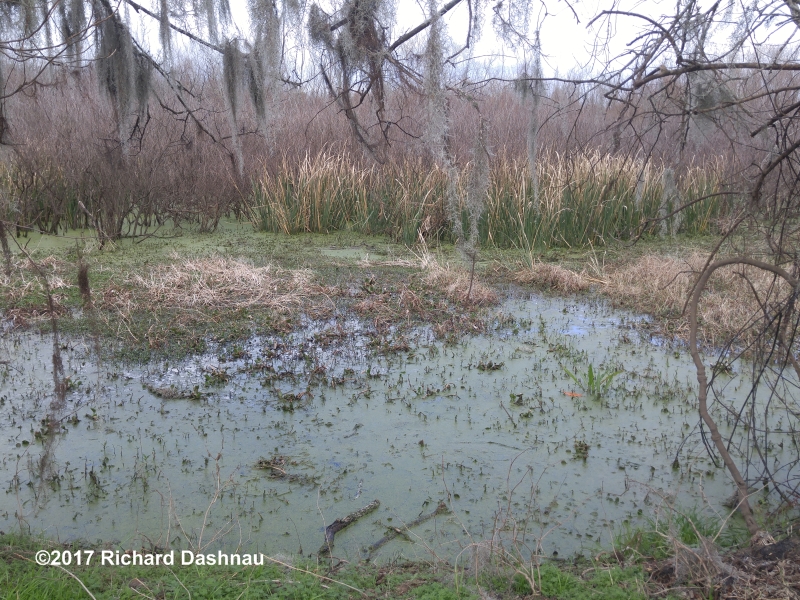
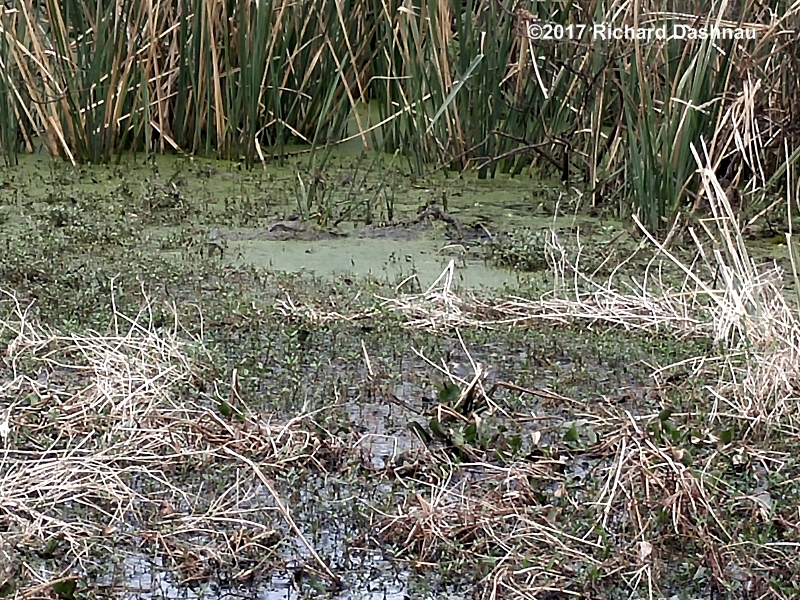
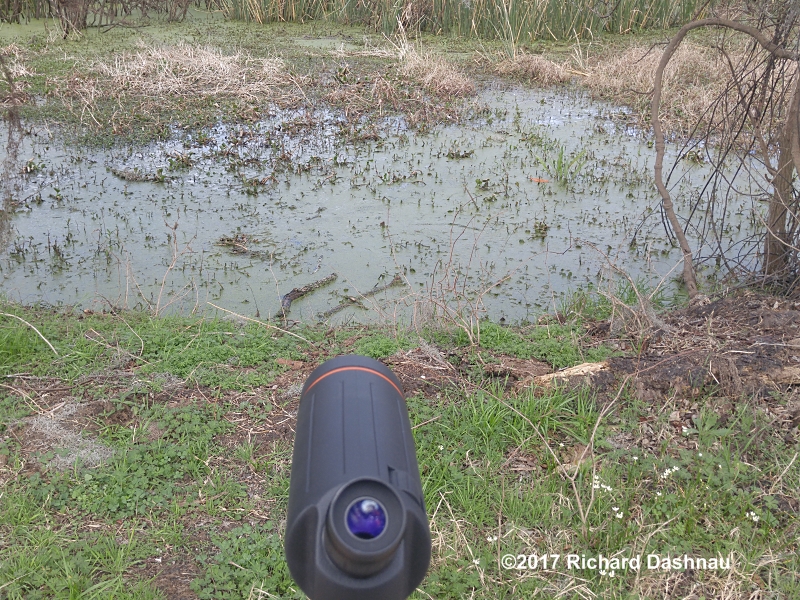
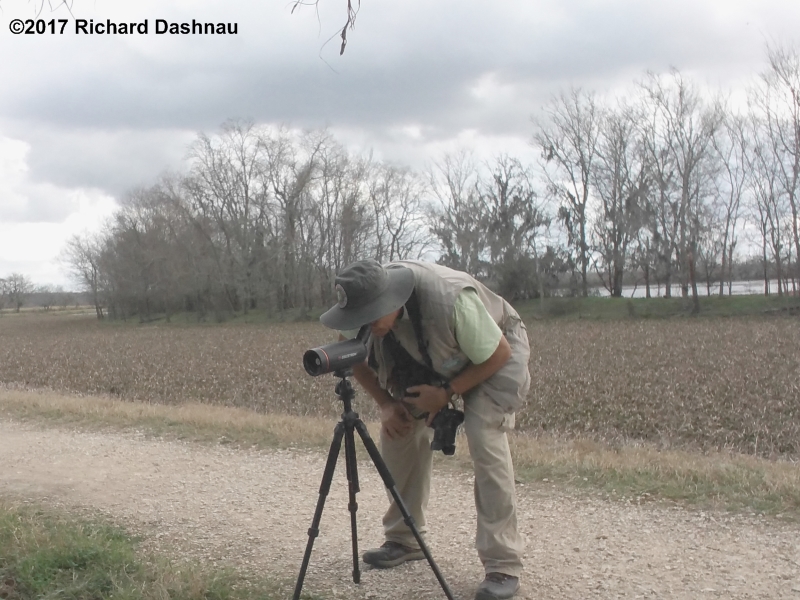
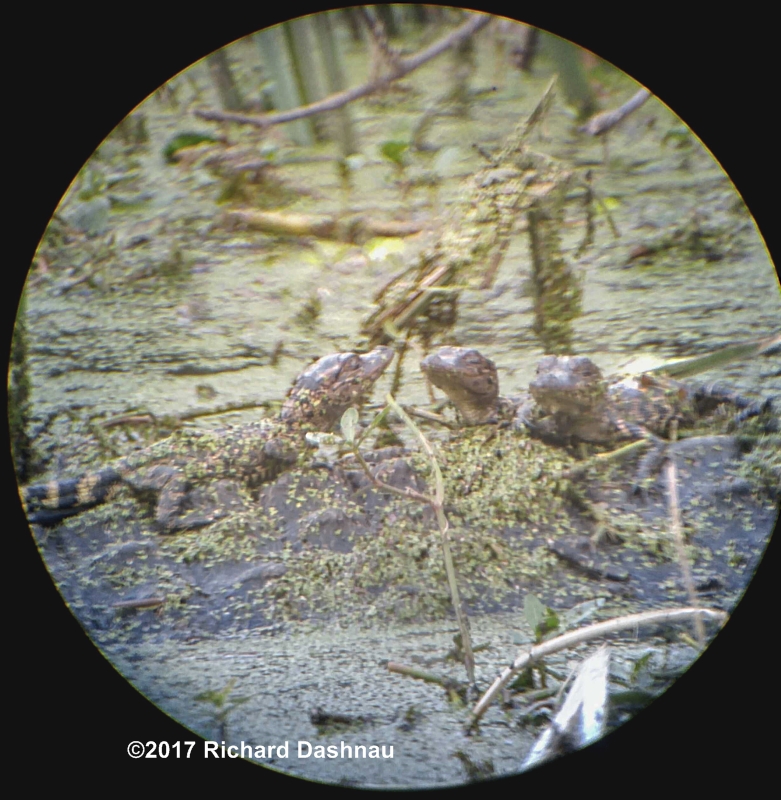
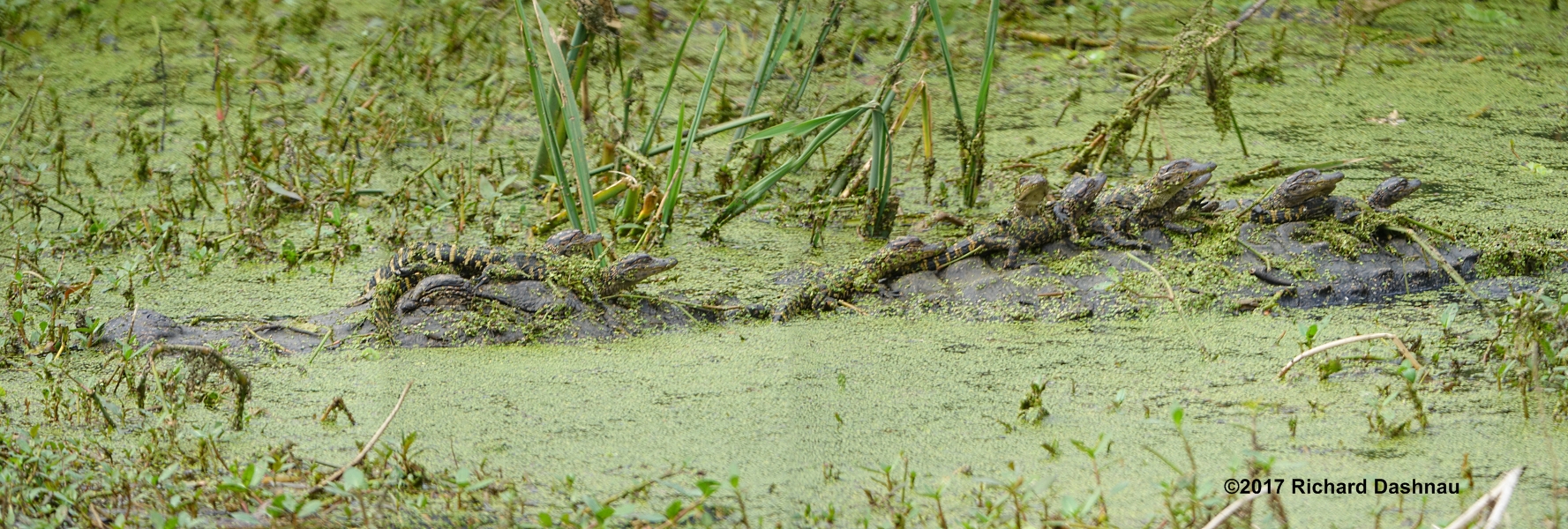
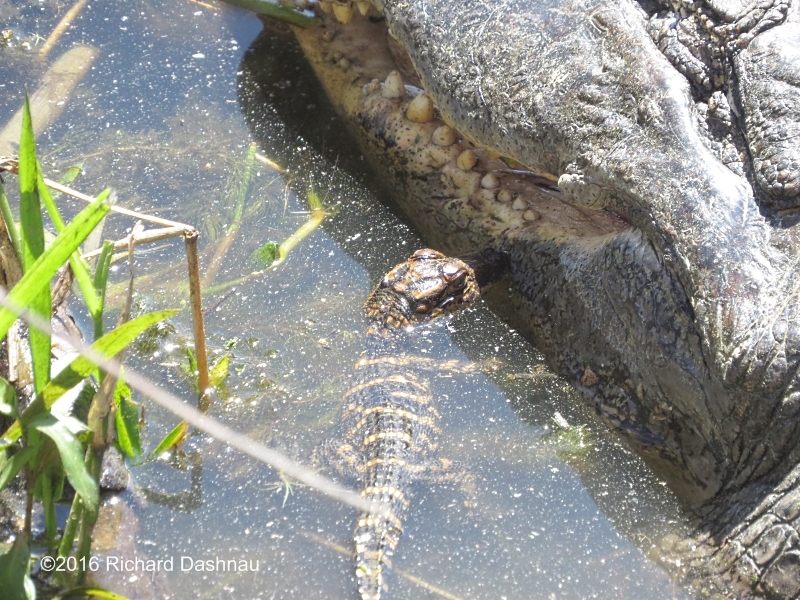
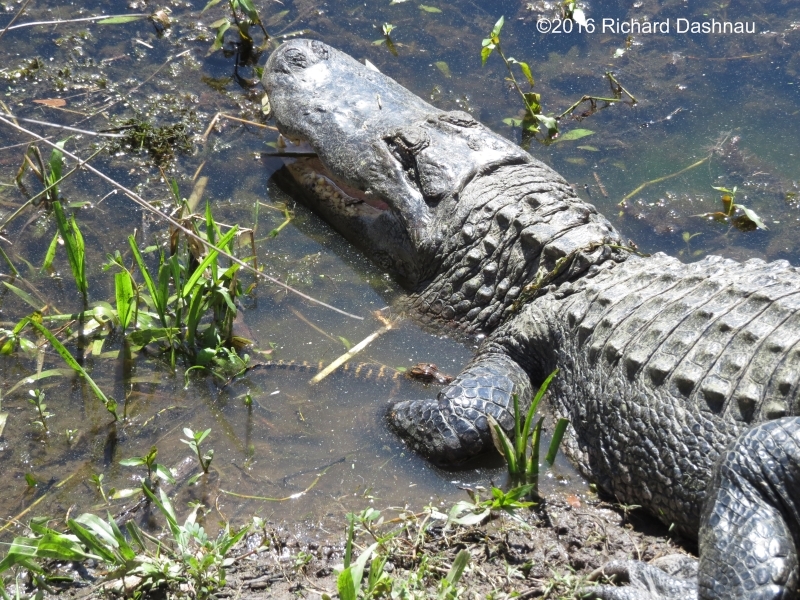
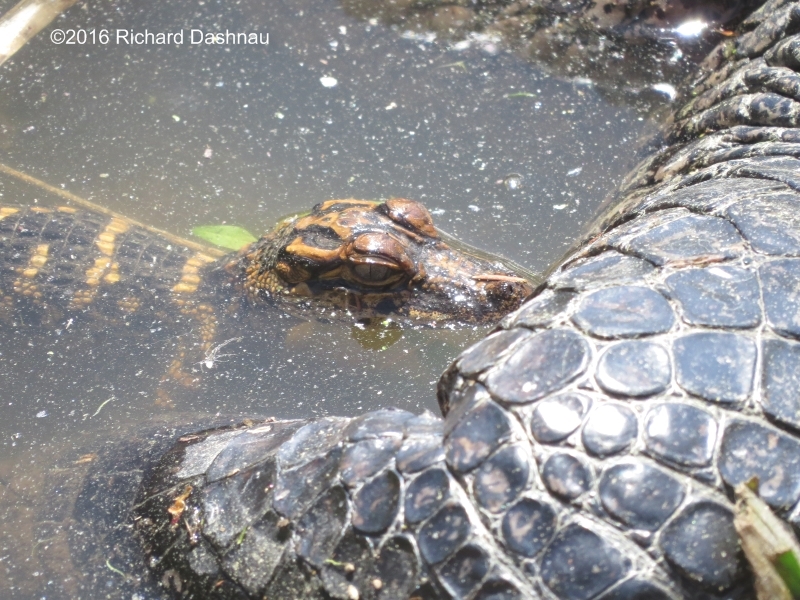
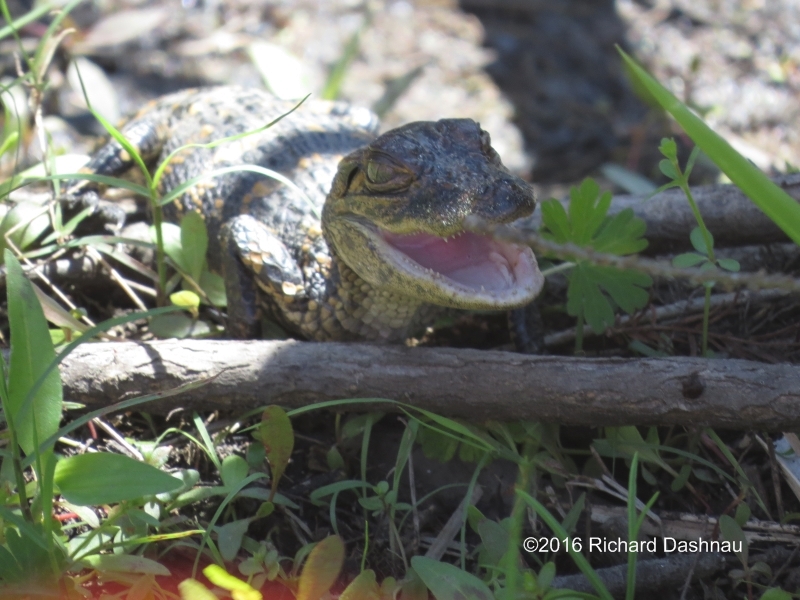
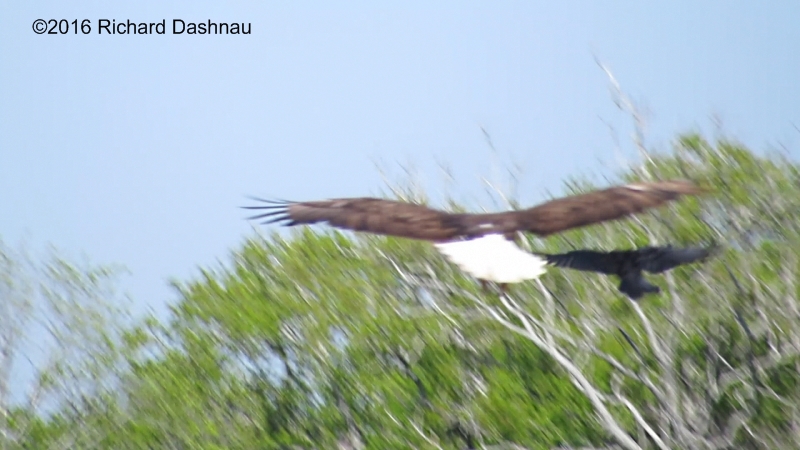
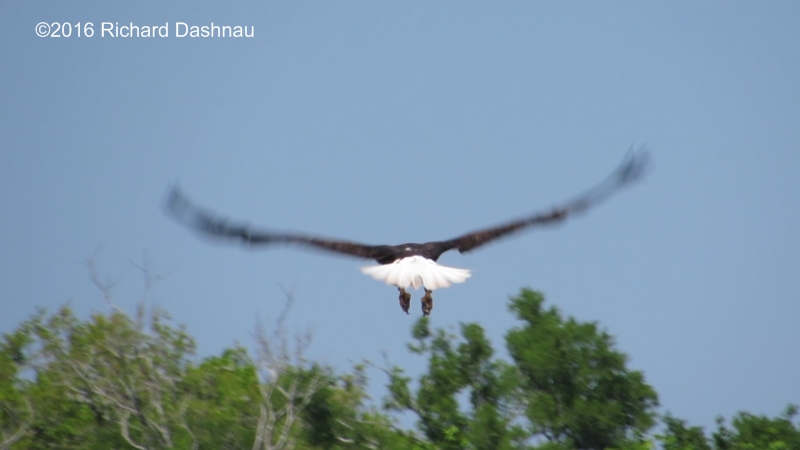
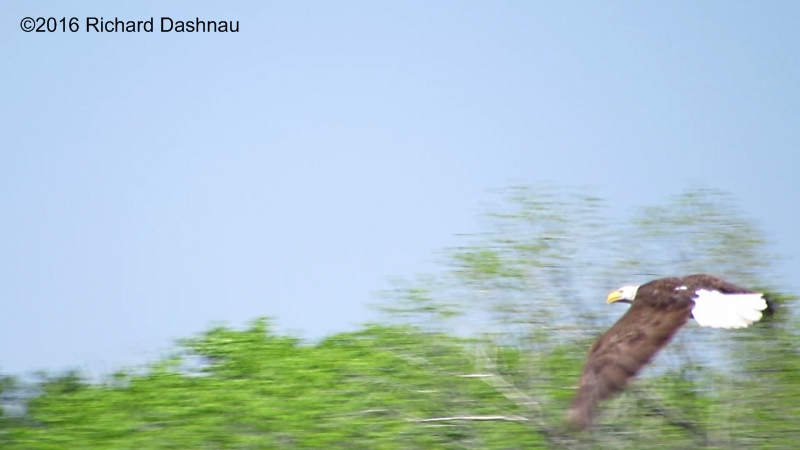
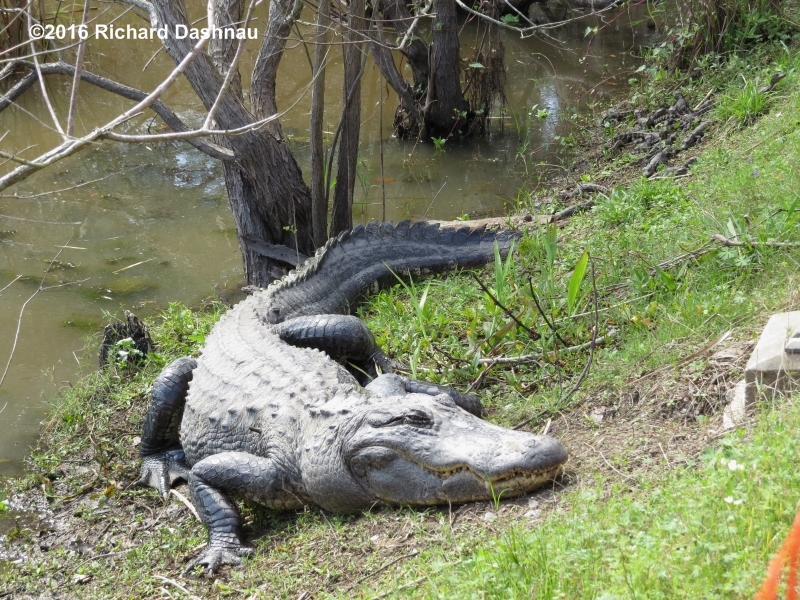
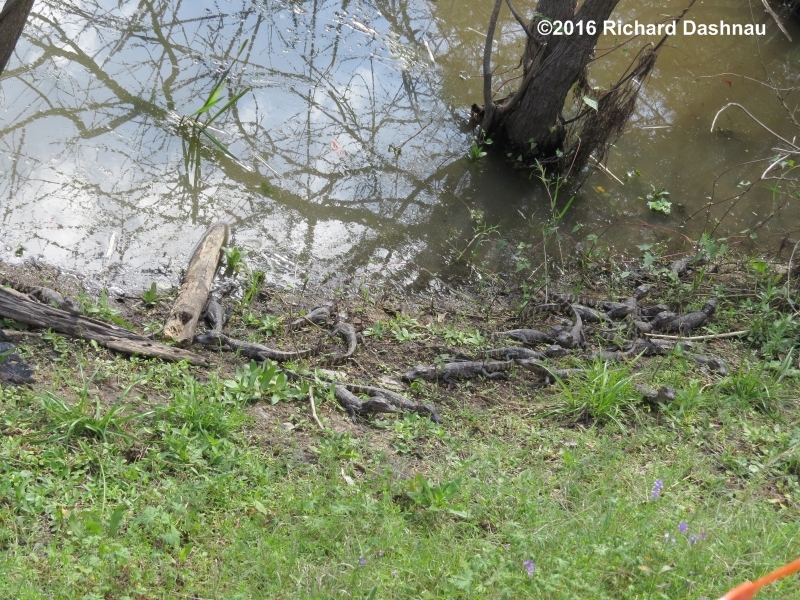
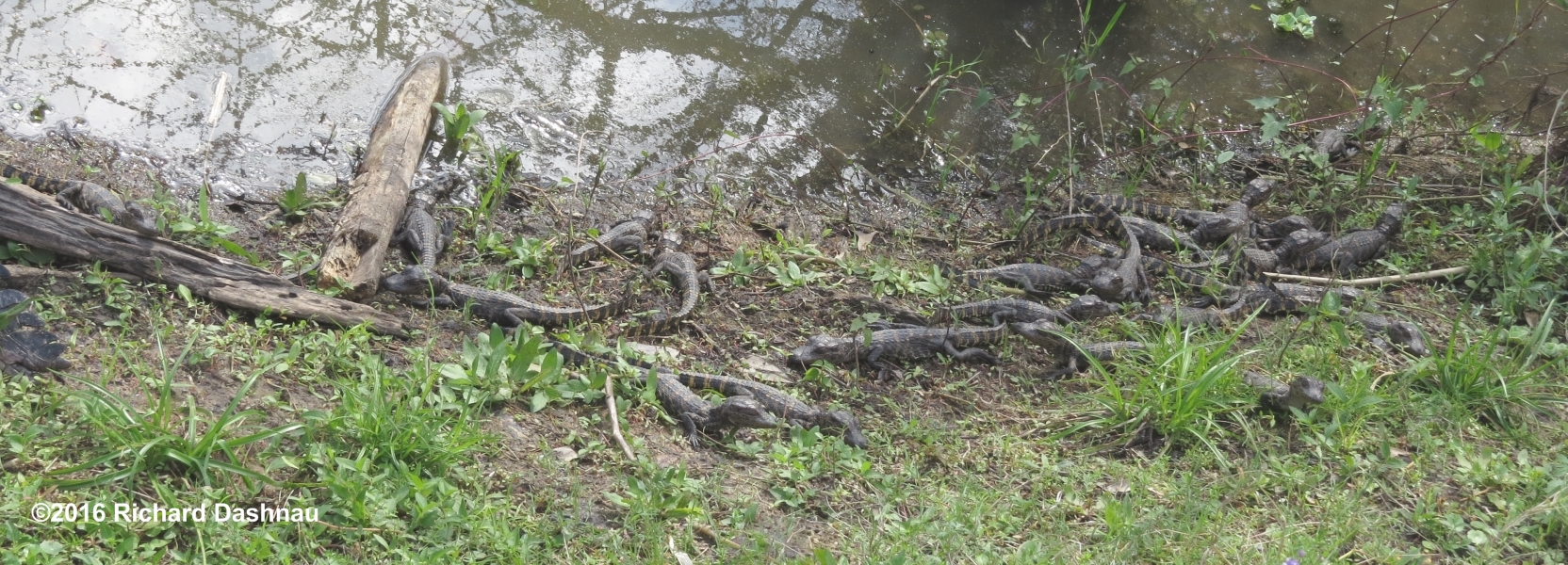
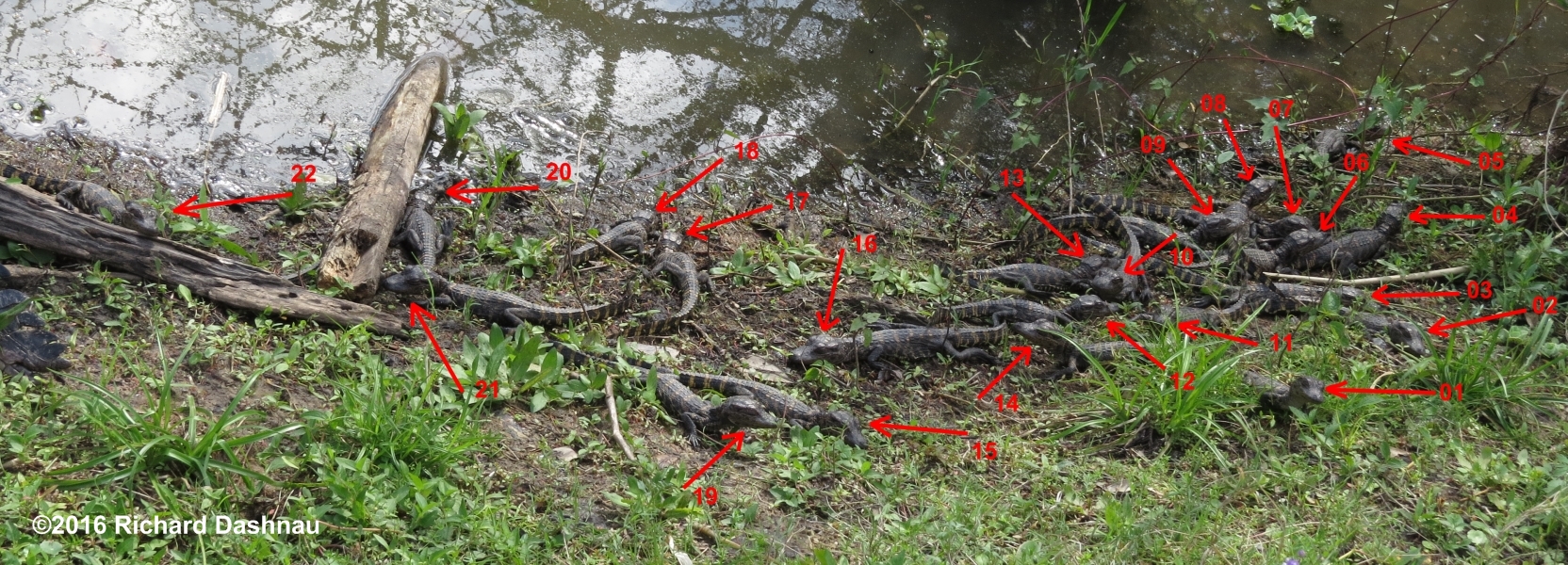
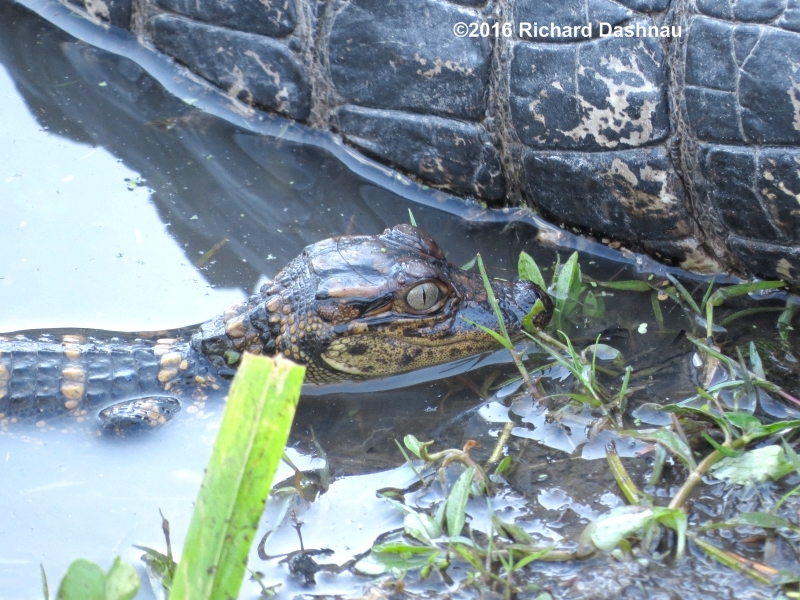
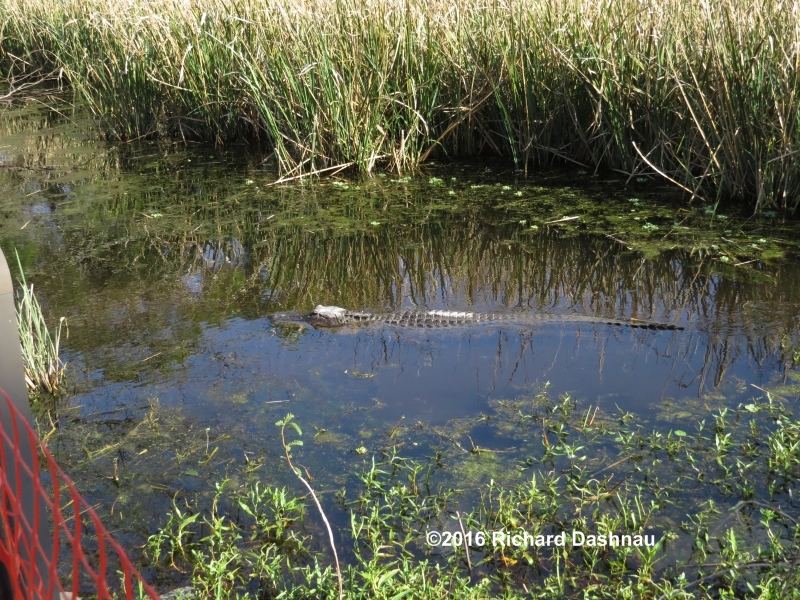
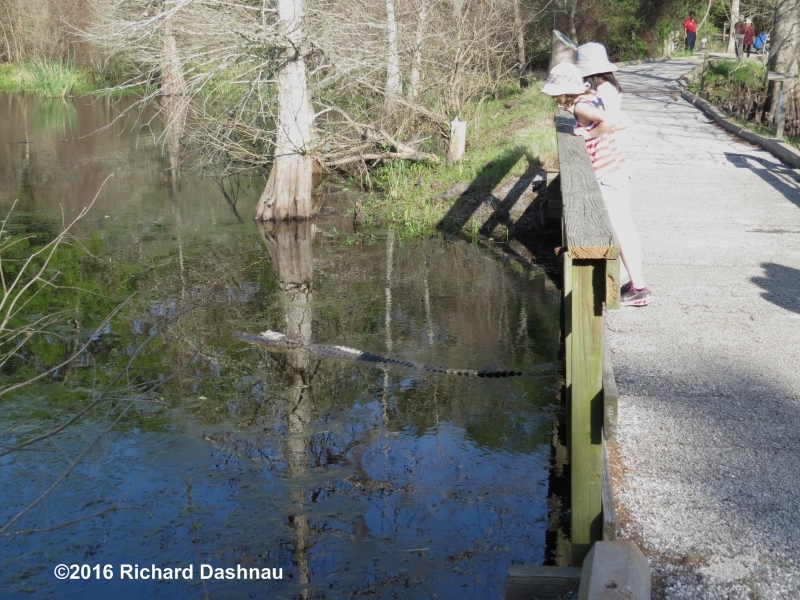
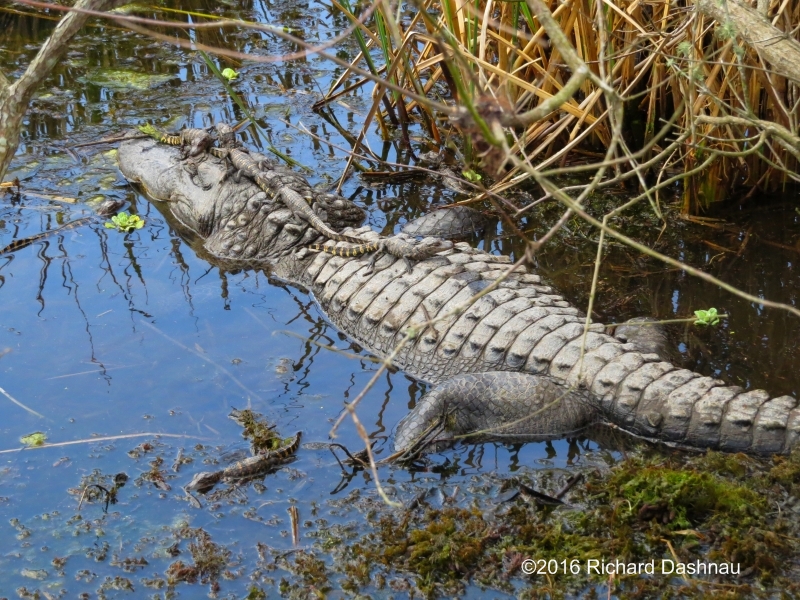
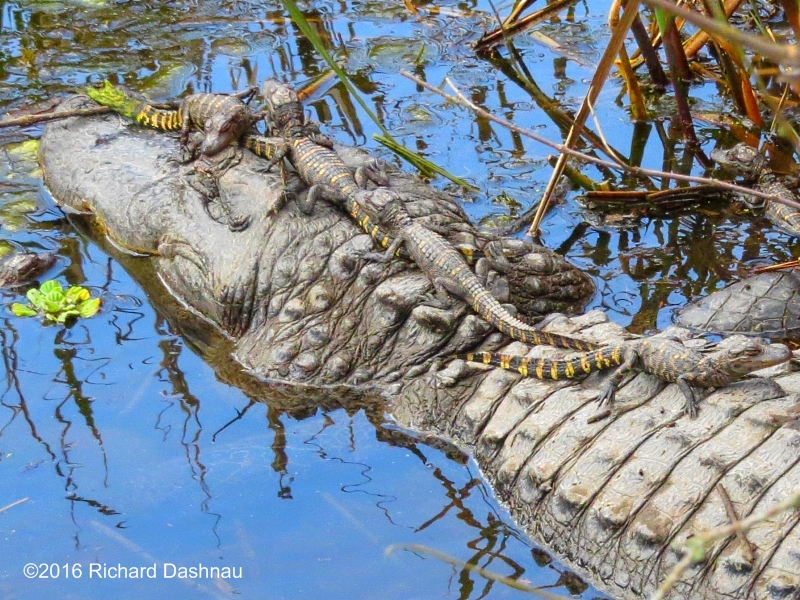
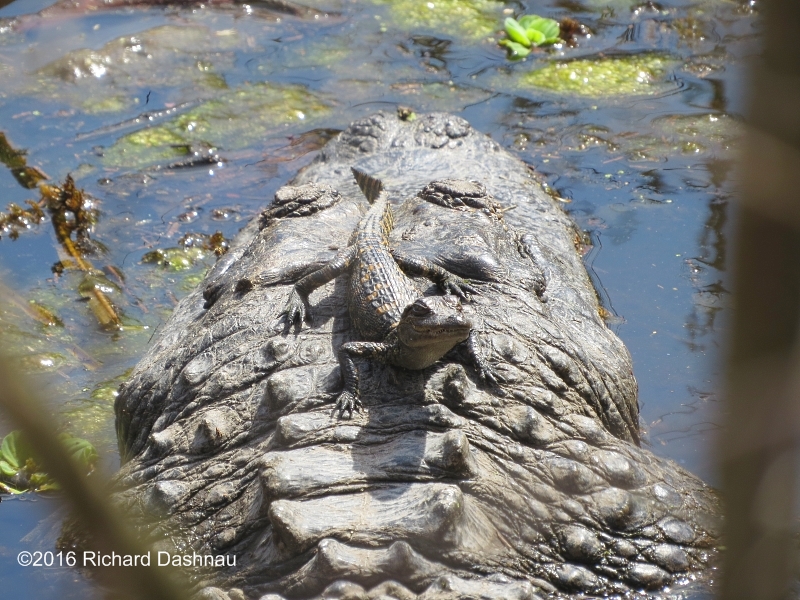
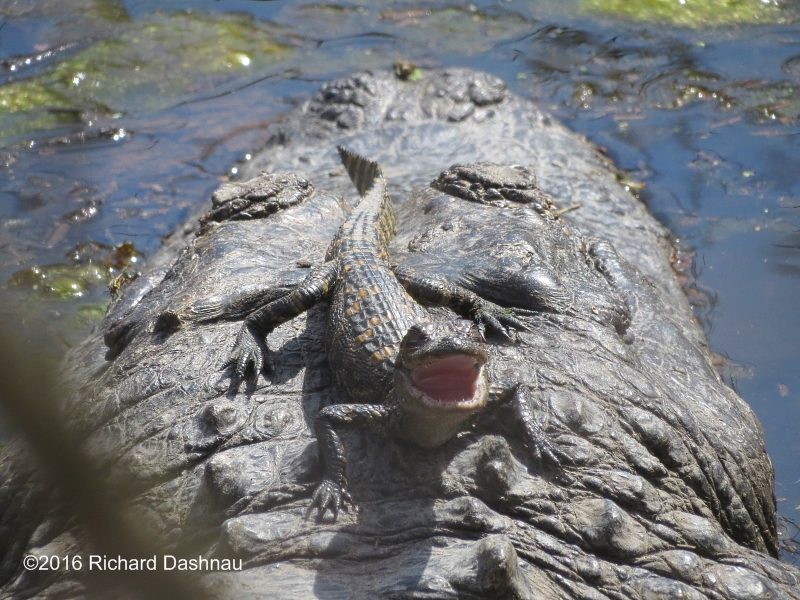
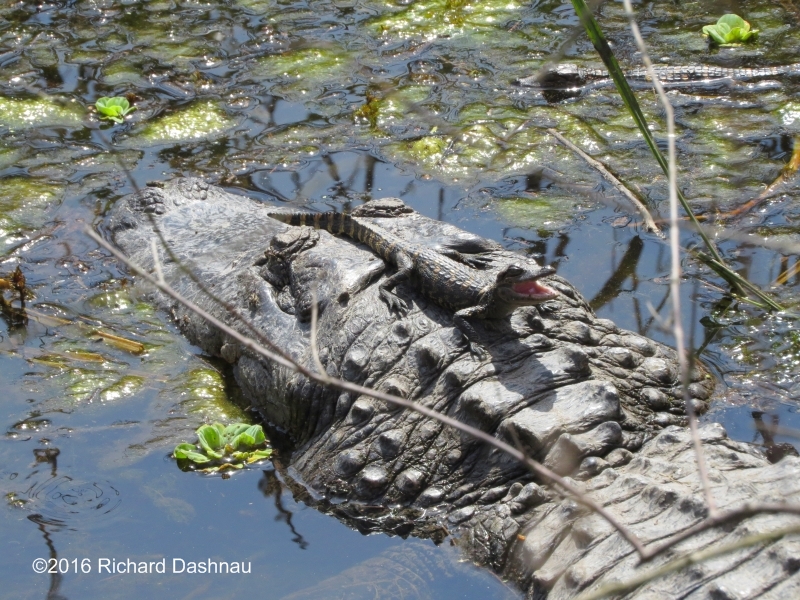
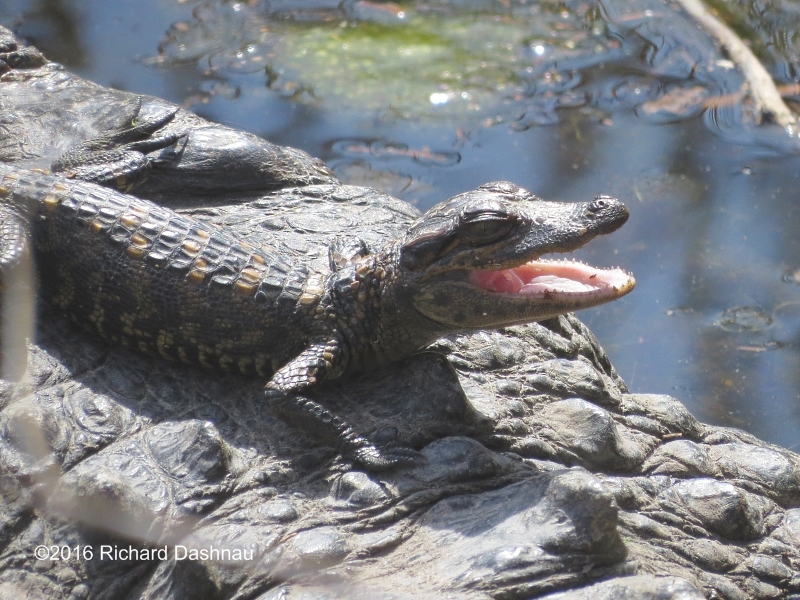
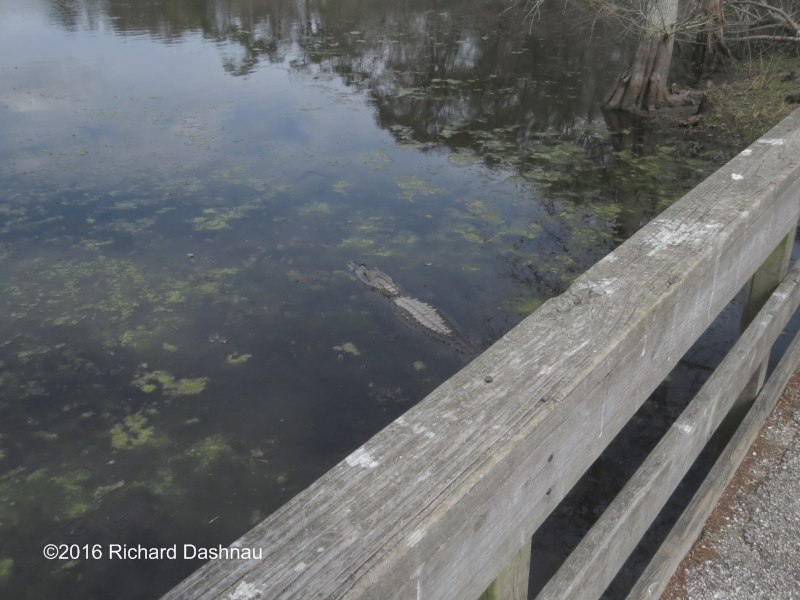
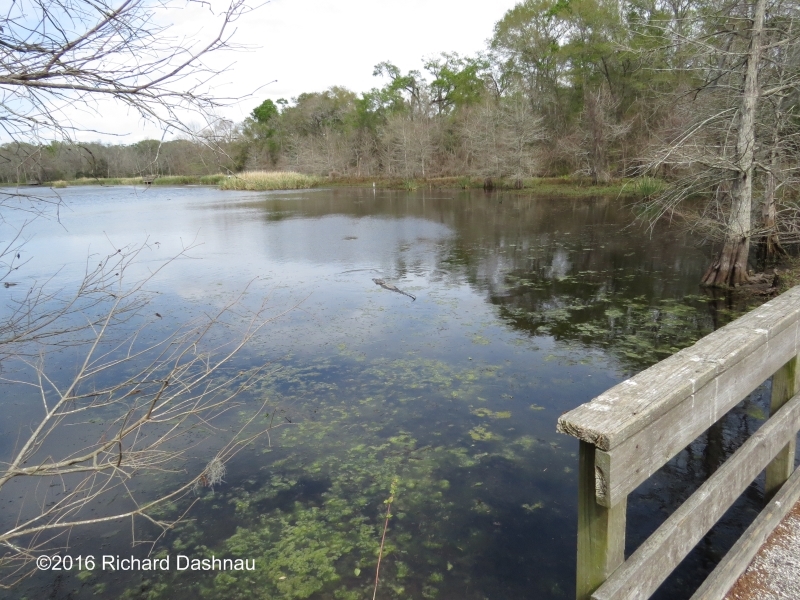
09/28/2014 Just one of many pictures of the mother alligator and her babies at the spillway trail nest. Just one cropped image as a reminder that I need to post more of them.
November 4, 2012
Sometime
around 12:30, David told me that Greg and Joann had come by the VC.
They mentioned that the female alligator with babies at 40 Acre lake
that we've been
watching had appeared, and the babies were crawling on
top of her. EVERYONE likes to see this, and get pictures of baby
alligators on top of their mother. But I had to set up for my
program,
and wouldn't have time to go out to see them and get back. So I didn't
go.
I was doing my Hard To Be an Alligator program when my
cellphone chimed with a text message at about 2:07PM. Later I
saw
David, and found out he'd sent the message. The female
alligator with
babies at 40 Acre lake had crossed the trail. David
explained that
when he passed by them on the way to the Observation Tower the mother
and babies were in 40 Acre lake,
but when he came back the other way,
they had the crossed the trail into Pilant Lake. A handful (about 6
babies) were in Pilant Lake with her. David said the mother
alligator had been a bit
agitated, and was circling around. This
is probably the same alligator that I talked about lower down on this
page (August 19, 2012).
I
decided to go out and look. When I got there, about 3:30, I could see a
number of people standing on both sides of the trail taking pictures
something in the water. As I walked up quickly,
the groups broke up and
moved away. I could see that they had been taking pictures of the baby
alligators in Pilant lake and their mother (which
was near
the wild rice); and also the group
of baby alligators in 40 Acre lake.
When the people moved off, I moved about 10 paces west of both groups
of alligators. This put me out of a direct path between the groups, and
far
enough away (I hoped) so the baby alligators wouldn't pay attention
to me; and the sun was behind me so I wouldn't be looking into it. Then
I waited.
After some time, I noticed stirring in the plants at the
water's edge of 40 Acre Lake, and I knew at least one baby alligator
was coming ashore. But a few people came by, and the movement
stopped.
David appeared on his bike, and after some talk, he moved East (towards
the tower) about 10 paces on the other side of the alligators, while I
stayed where I was. Time passed,
and we tried to keep people from
standing near the two groups of babies. We both explained what we were
waiting for (baby alligators crossing the trail) but nothing happened.
David
eventually rode off West (and headed off an oncoming John Deere
gator on the way). I stayed and waited. There was more quiet
time
without any passing visitors. During that time, the
mother alligator
moved into the rice; then stayed quiet for a while. Then she'd come
out, move around, and go back into the rice. When she moved, the babies
that were scattered around
her in the water would chirp.
Finally, at
about 4:18, I was rewarded with more movement in the grass. One tiny
alligator appeared near 40 Acre Lake. Then another. Diane, one of our
previous Volunteers, happened by
at about that time. We watched as the
first few babies moved through the grass and climbed closer to the
trail. And then one just started walking, and crossed! And another
followed close
behind. Others started appearing in the grass. I was
able to shoot some photos and video
clips of the first babies crossing.
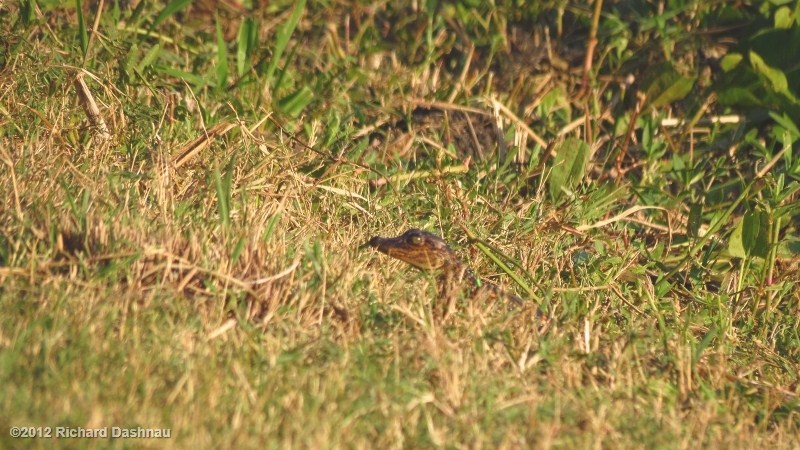 -
-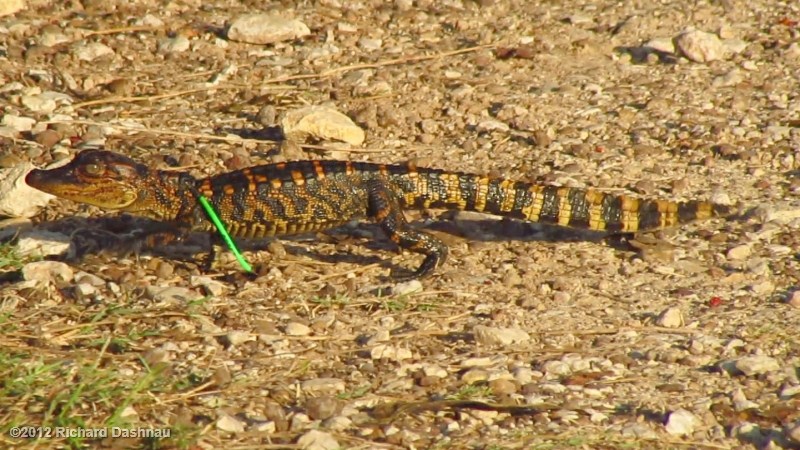 -
-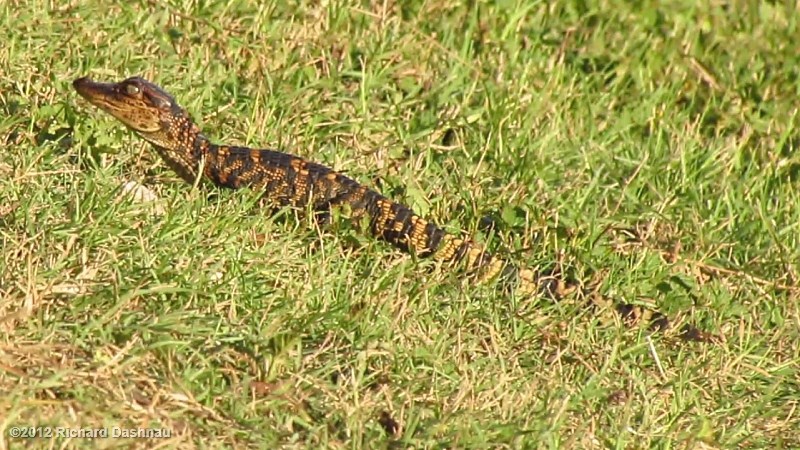
I
had to stop shooting to stop park visitors from walking over the baby
alligators. But that was fun. More visitors started coming by. Quietly,
I motioned for them to stop, then motioned them to
approach
slowly. While stopping the visitors (and keeping them quiet
them)
I whispered about what we were seeing. Unknown to me at the time, Diane
had been counting the babies as
they crossed. I tried to communicate
how very VERY rare the sight of this "parade" was. From what I could
tell, the 15-25 people who came by were all engrossed by what they saw.
At one
point, as I explained how special this was (we were actually
seeing something many of the park folks have been wondering about for
years!) and when I said that a number of them had
crossed so far, Diane
then mentioned that 12 had crossed (or 14 at that time). I
explained how the female crossed earlier and how she defends her young.
Yet, I pointed out, as we were
watching, any number of park predators
could have grabbed one of the babies from 40 Acre lake--or what would
happen if they just got lost? But, in this case at least, they followed
their
mother into Pilant Lake.
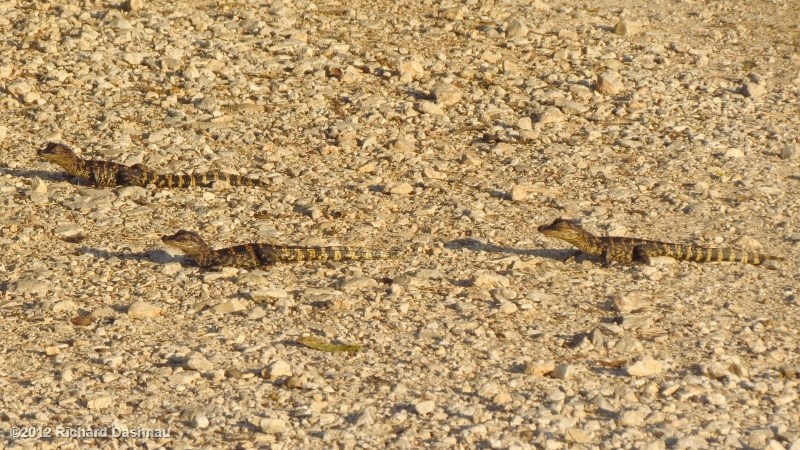 -
-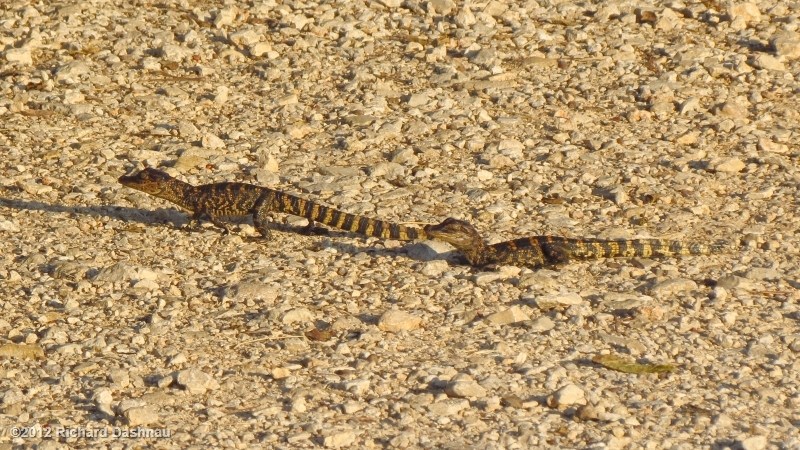 -
-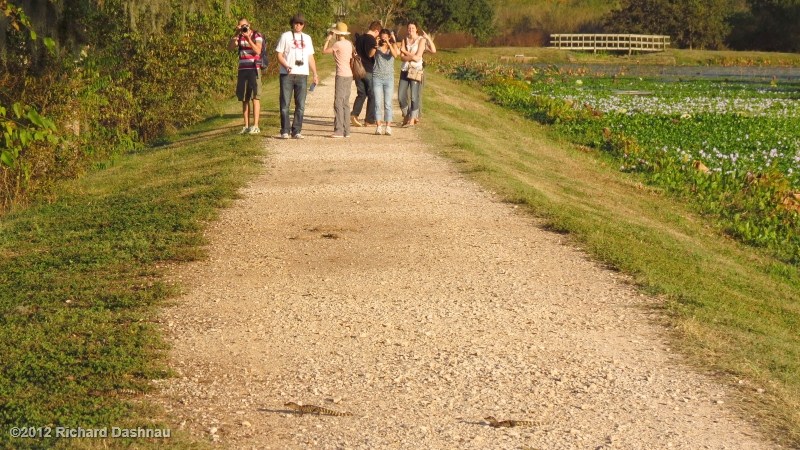
People
were coming from both directions, but I was able to stop them with hand
signals. It helped that almost everyone behind *me* was gesturing and
whispering to stop as well. They were
*all* spellbound as we watched
the tiny alligators crossing the trail. It was kind of funny at one
time, when 2 folks on bikes came from behind and the whole crowd
quietly waved them to stop.
I whispered that alligators were crossing
the trail. They looked, and couldn't see anything--looked at us like we
were crazy. Then...a couple more little ones came out of the grass.
Alligators
were crossing, but at about 8 inches each, quite a bit
smaller than the 6' or greater ones that usually cross.
Everyone
cooperated, and as a result, we got to watch 16 alligators cross the
trail. As the babies straggled across to Pilant Lake they
began
chirping. After a while, the mother alligator
would come out of the
rice, and approach the bank, and wait for the babies to swim to her.
Then she would move back toward the rice. She did this a number of
times--swam out towards
the trail, met some babies, moved back to the
rice so the babies would follow.
Baby Number 17 chickened out turned
back towards 40 Acre Lake. At this point the sun was going behind
clouds, and it was starting to darken. So I walked past the babies, and
couldn't
see any in the grass. But...there were at least 3 more still
in 40 Acre lake. I know because I saw three in the water--but didn't
count more. I figured I'd leave and that the remaining babies
would
cross later.
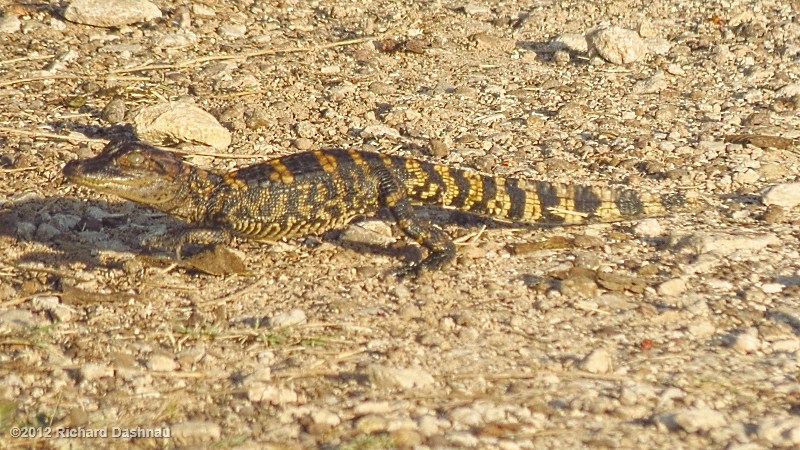 -
-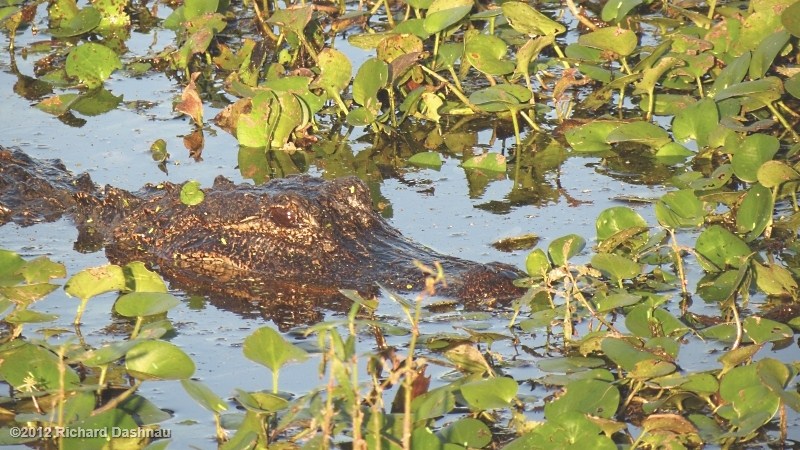 -
-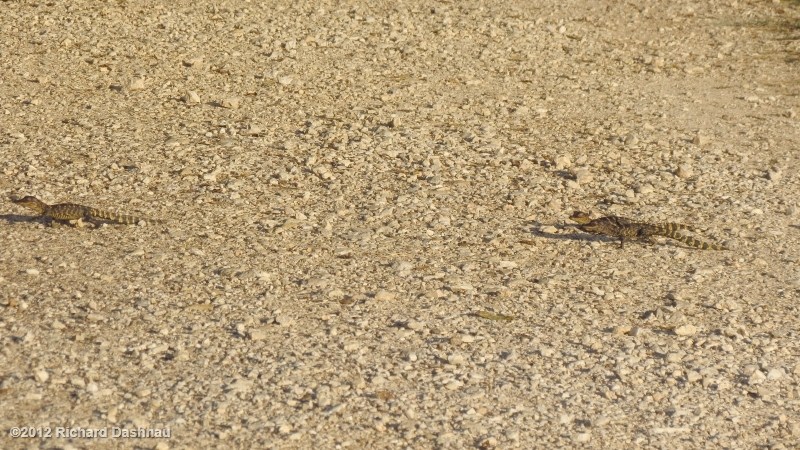
Although
I would have gotten more photos and videos if I had kept "filming"--it
was much more rewarding to get all the other park visitors involved. It
was a REALLY wonderful thing to
see--especially when everyone
understood who and where "mom" was, and what went on before, and how
alligators defend their young, and much more. That helped put the tiny
wanderers
into a greater perspective.
Consider this. The babies
*knew* which way to go to follow their mother. They couldn't possibly
see her. Mom did vocalize once or twice, a sort of low growl-but that's
all. I had assumed that
the sound was to keep *us* away. The
babies near her did chirp often. But the babies came to the point
nearest where their mother was across the trail. They gathered there.
And then they
climbed up through the grass and crossed the trial, then
back down the other side--to where they were met by their mother. They
did not spread out in 40 Acre lake. They did not swim back
towards the
islands. They moved to where the mother alligator was. How did they
know which way to go? Did the chirping do it? I've noticed some other
things baby alligators do--how they
will seek each other out in a tank,
or after travel; and that they will often clump together to sun
themselves in the wild, or they just maintain a group in the wild. It
sure looks to me like some
kind of social activity and more than just
automatic "seek out the 'alligator-shape'(whatever that would mean to
an alligator) because it's safer to be in a group". I suppose those
are
distinctions that the animal behavior people could make. The pictures
are either still photos or edited from frame grabs from the
vide.
The
edited video is here
(.wmv 53mb) or here
(mp4 98mb)
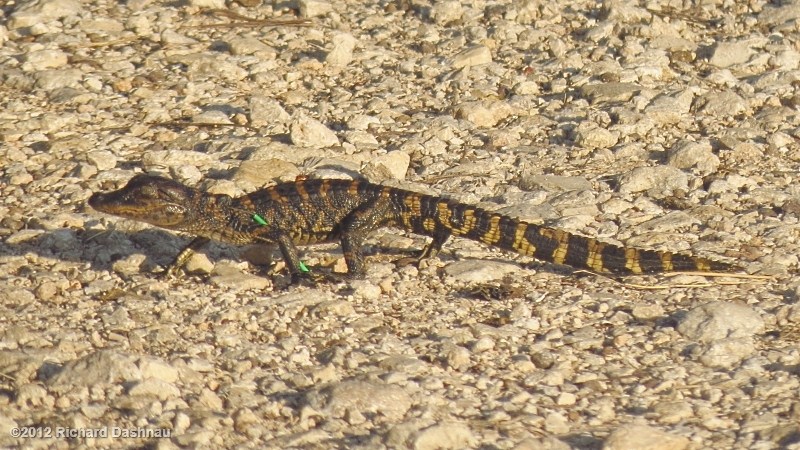 -
-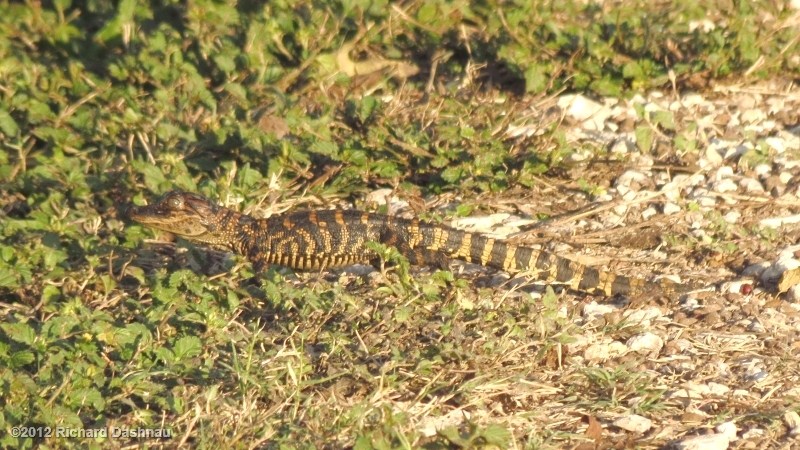 -
-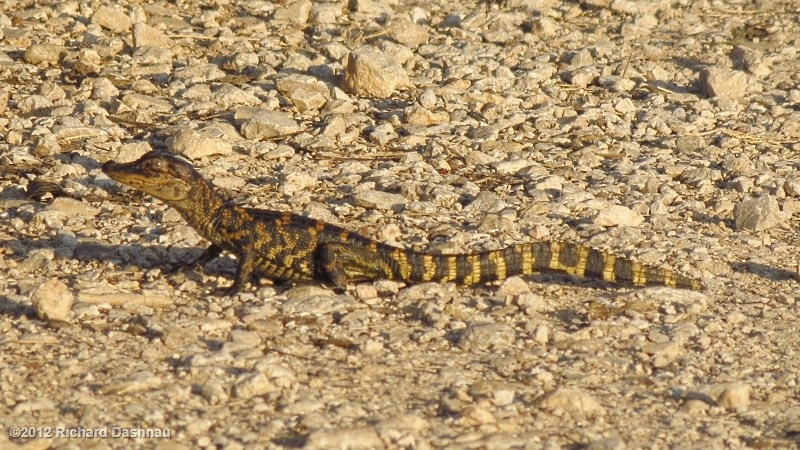
August
19, 2012-- This
story actually started in May. On May 27th, a park visitor reported an
alligator digging a nest at 40-Acre lake. Alligators had been
bellowing
there that morning (I know, because I was there) but I had totally
missed seeing the alligator and the nest. I went back and took some
pictures (one is shown below). After that, I
inspected the
nest (which was on one of the islands on the lake--about 50 yards
across the water) almost every weekend. I wanted to get a picture of
the female on land near the nest. But,
she never appeared in that
position. I did get some pictures of her in the water near
her
nest--the pictures from 06/10/12 and 06/17/12 below show her clearly.
I
continued watching through the summer, although I didn't take pictures
every time. For most of the summer, I didn't see her at all, and I
worried that something had plundered the nest, or she
had abandoned
it. I have a picture from 07/01/12 (below).
Although there
is no alligator in the picture, it does show that the water
level has dropped. Since the nest is
on an island, the
female could have been on the other side, in the
water. Nothing changed during the first part of
August.
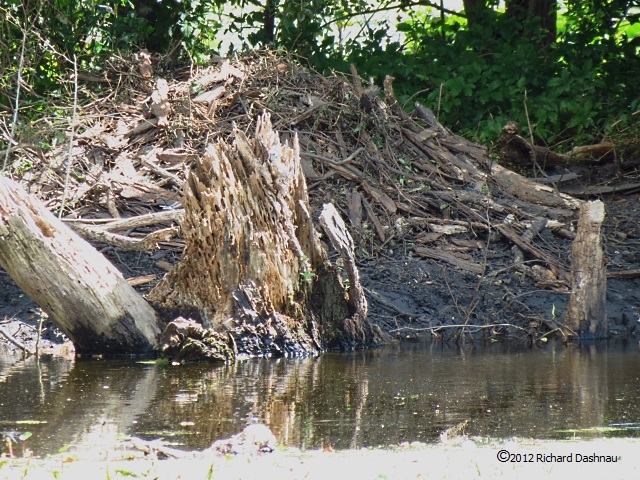 -
-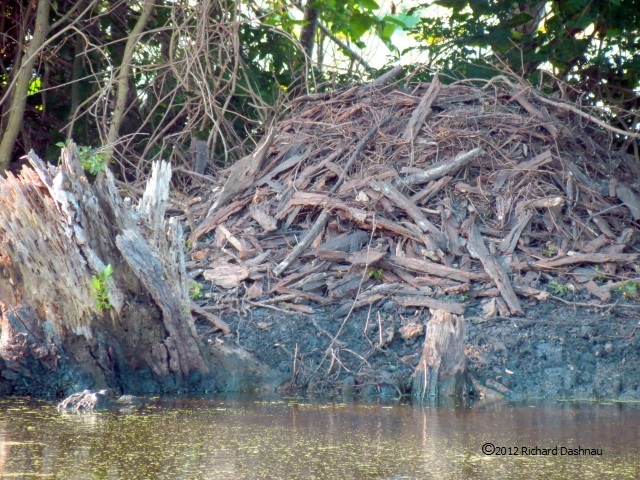 -
-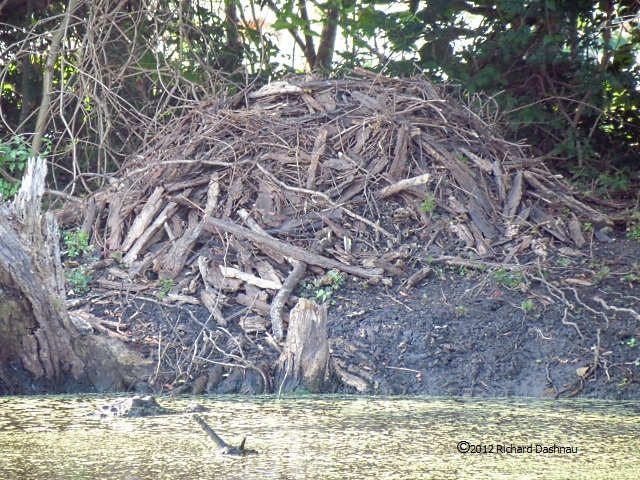 -
-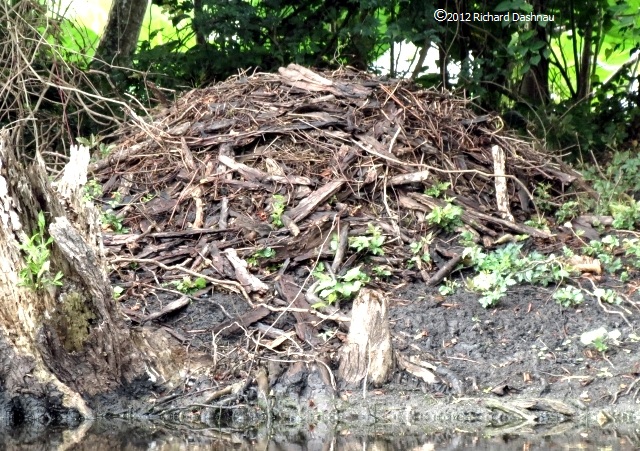
nest_052712
nest_061012
nest_061712
nest_070112
On
Friday, 8/10/12 the alligator eggs that were incubating in
the
Nature Center hatched. I started paying closer attention to the nests
outside. Then, on the morning of 08/19/12, I looked at
the nest, and
saw the image below. The nest had been devastated!
The top
had been dug out, the bark chips pushed aside (interesting--they were
just a veneer), and I could see a few
fragments of egg shells near the
when I looked through binoculars.
-------------------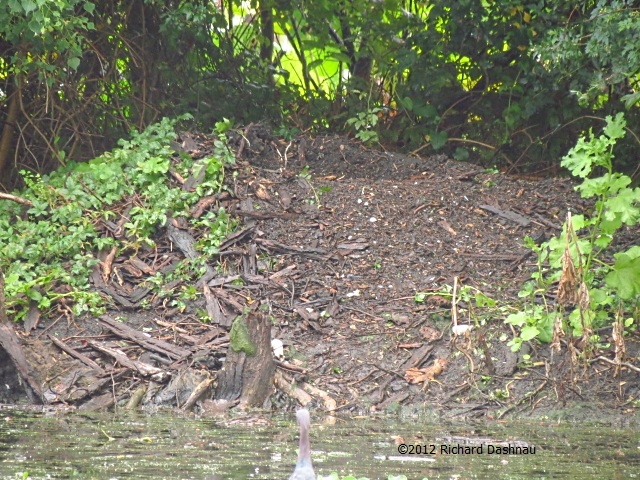
nest_081912
COULD BE TROUBLE.....
But
I remained hopeful as I scanned the bank of the island. Finally...I saw
it. Tiny yellow vertical lines. On a tiny body.
Then
another. And...there was a large alligator's head with more of
the
tiny
alligators around it. THEY HAD HATCHED!! The image below is
stitched together from photos I shot from 50 yards away. And, there is
a video clip here
(wmv) or here
(mp4).
The video
clip is compiled from shots I took at full optical zoom
(35X), and then others that I shot with full digital zoom (140X) and
compressed so they'd be clearer. In the video clip, the
babies
are
crawling around, and some seem to be catching food. I counted
at least 13 babies....but at that distance it was hard to make them out
if they were clustered together.
-
THE
MOTHER
...AND MANY OF HER BABIES!!
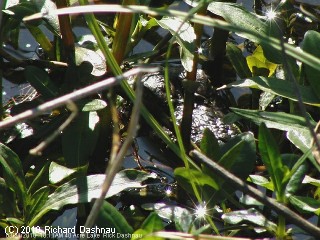 --
--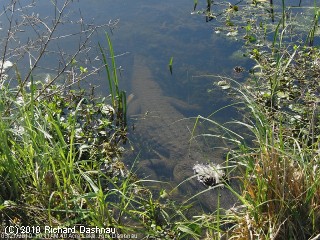 -
-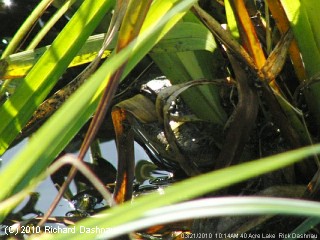 --
--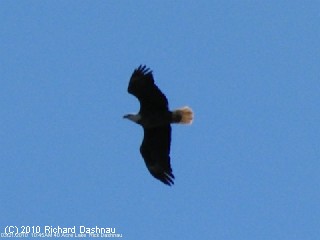
BABIES 01
BABIES 02
BABIES 03
BABIES
04(WELL...NOT BABIES)
March 21, 2010.
The temperature was 40 degrees when I got to the park at about 8:30. I
hurried down the 40 Acre Lake Trail for two reasons. One--to see if a
Bald Eagle
would fly over or
hunt; and Two--I was very curious about what the baby
alligators that have been seen there would be doing during this cold
weather.
I easily found the female that had been with the babies.
She was lying
in the water with just the top of her head and her nostrils above the
surface.
The water was very clear, and I was hoping to see the baby alligators
near
her in the water and lying
on the bottom. No such luck though. However,
after careful searching I found 3 baby alligators hidden among the
weeds.
At 10:11, I shot this photo of one of them (01). Although immobilized
by
the cold, it is still very well hidden. Here's the mother at the same
time
(02). At 10:14 I photographed this one, again well hidden, at the base
of a clump of grass (03).
Nothing
happened for a while, except that I talked to a number of park visitors
as they passed by. As a couple moved by, and were headed towards the
Observation
Tower, a HUGE flock
of White Ibis flew in front of them, heading out over
Pilant Lake. Quite breathtaking. So much so, that I stood there and
gaped
instead of snapping a picture.
Above
and behind them (and
almost in the sun) a large bird flew in the same direction.
I took a quick look through my binoculars--then dropped them and
grabbed
my
camera.
The bird was far from me, but I got one shot
at about 10:45. This was the
best I could do with the photo (04). The bird was far off. I tried to
walk
after it, but as I
watched,
it seemed to drop out of sight. But I could see enough to be sure it
was
a Bald Eagle!
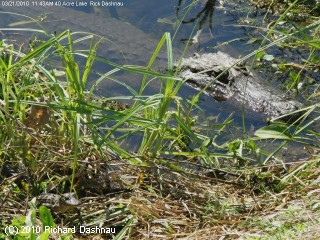 --
--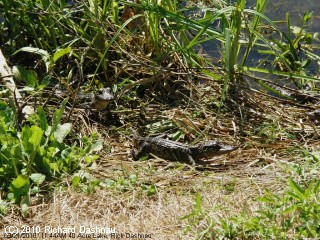 --
--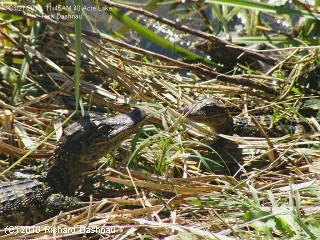 ---
---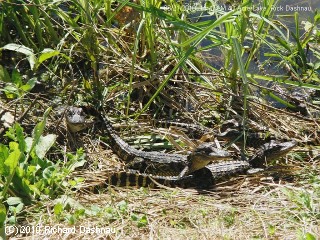
BABIES
05
BABIES 06
BABIES 07
BABIES 08
At
about 11:40, one of the small babies appeared, and a minute or so
later,
one of the large ones. I shot this (05) at 11:43. After that, one baby
after another appeared from
the
same spot in
the water in the grass. I shot this (06) at 11:44; and then
11:45 I got these two moving towards each other (07). In another few
minutes,
at 11:47 it started to
get crowded (08). This group
probably represents the offspring from two
years. The smaller babies would have hatched around last September, and
the larger babies probably hatched the year before that. They
are
still
so small because they wouldn't eat much (if at all) during the months
October
- February. It was an uncommon chance to see these young alligators.
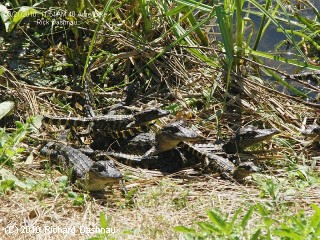 --
--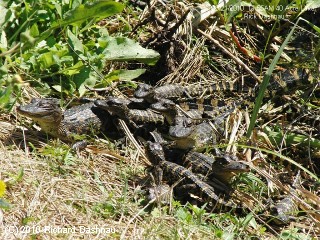 --
--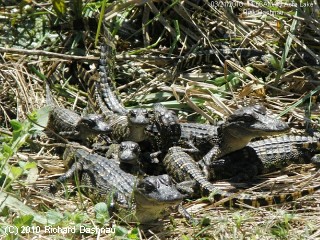 --
--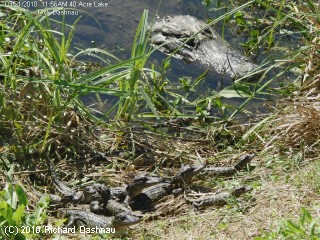
BABIES 09
BABIES 10
BABIES 11
BABIES 12
Notice
how many of them are appearing from the same direction. Here's the pile
(09) at 11:51; from another angle (10) at 11:55; and from other angles
(11,12) at 11:56. From then, they just
laid in the sun all day. From time
to time through the day, the mother would back away from the shore a
few
feet (13). She'd stay in the slightly deeper water for a little while
(I
didn't time it) and
then move back to her spot near the bank (14). This
seemed like odd behavior. She wasn't hunting. I finally guessed that
since
the temperature had dropped so quickly, the water would be
warmer than
the air--especially the deeper water--and the female was actually
"warming
up" by retreating to slightly deeper water. But, that's just a guess. I
stayed with these alligators for most
of the day, until I left at about
3. I'm passing on this story so we can help dispel some of
the worry
that some of our park visitors have for the baby alligators when the
weather
turns bad. They
sure looked ok to *me*. Today's RICKUBISCAM shot shows
one of the babies near the mother's head.
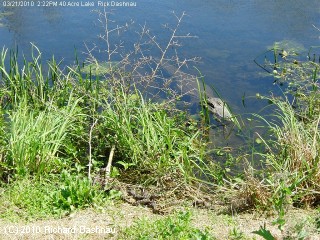 -----
-----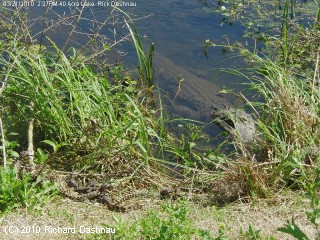 -----
-----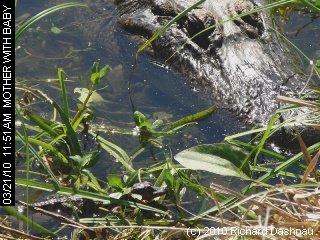
BABIES 13
BABIES 14
08/28/2009-
Even though this has been a dry summer through most of Texas, we had
one
or two good instances of rainfall this spring. Evidently, the
alligators
at Brazos Bend State Park liked
the amount water in the lakes (managed
very well by Park Manager Steve Killian) enough to make at least 24
nests
this year. As usual there is at least one nest that can spare some eggs
due
to questionable circumstances. This year a little over 30 were gathered
and incubated. Today, a few began hatching by poking their noses
through
the shells so we met to help the alligators
hatch. I was able to make it
this year. We had a good crowd (but not a huge one) for the
hatching,
and I even got a chance to hatch a couple eggs myself! Watching the
people
watching the
hatching is always fun; but hatching an egg myself...well
that's even better. With all the milling around and so on, I
couldn't
record a lot, but I've done it before on my other pages
(
babies
1 , babies 2
,babies
3 ). Here are a few pictures from today. Today's
RICKUBISCAM
is another shot of the newly-hatched alligators piled together.
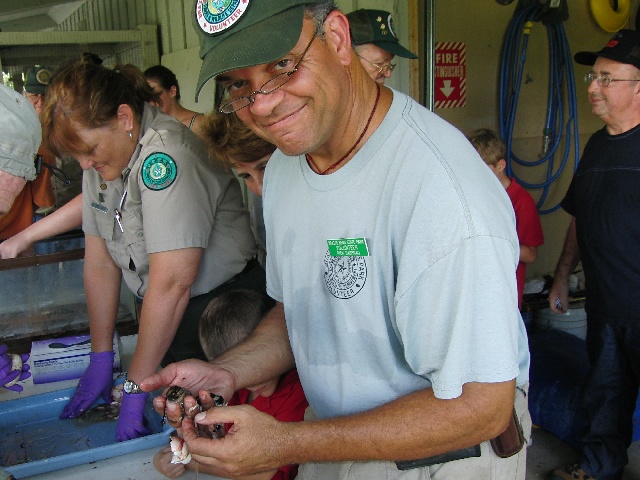 -
- 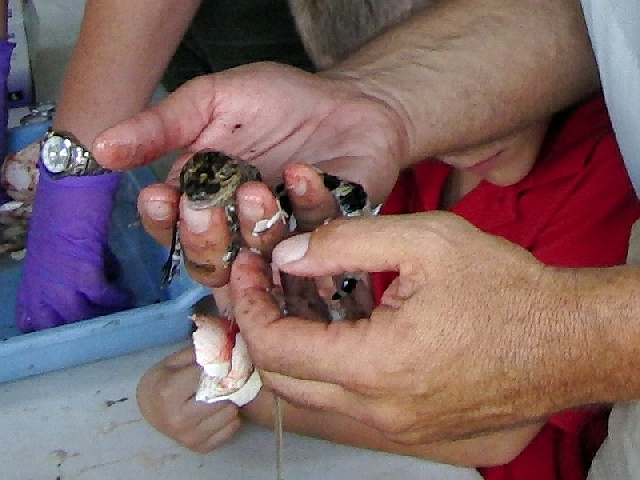 -
-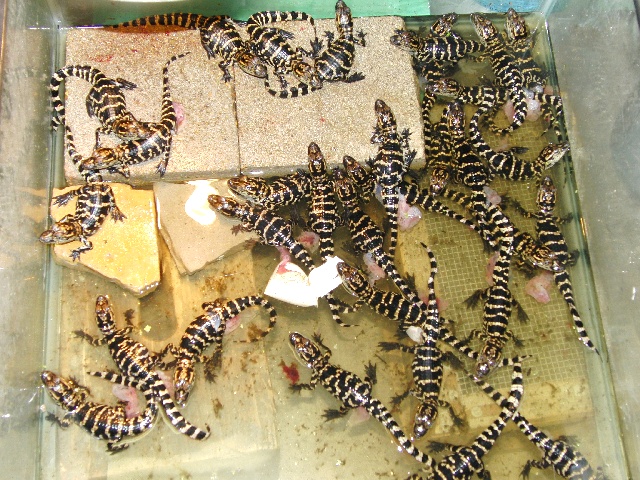 -
- 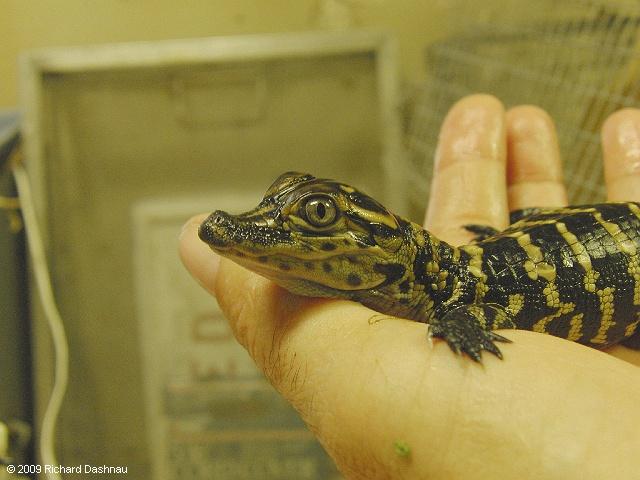
RICK
HATCHING AN ALLIGATOR
CLOSER LOOK AT RICK'S EGG FRIEND
CAN YOU COUNT THEM ALL?
-NEWLY-HATCHED,
ABOUT 30 MINUTES OLD.
The
story
behind these eggs--The park had borrowed about 33 eggs from one of the
alligator nests at Brazos Bend State Park some weeks ago (there were 24
nests reported in the park this
year). The eggs are placed in conditions
similar to the nest (dirt/vegetation/heat/moisture) for the remainder
of
the 60-day incubation period. For those of us who work at the park
(State
employees and Volunteers) this is an exciting time; and we await news
of
when the eggs will hatch. They are monitored constantly. This is
necessary
because it is possible for the babies to
suffocate in the shells if they
aren't released in time. This is partially because we can't exactly
copy
conditions in the field, so the eggshells sometimes aren't weakened by
the chemical/bacterial
action of the nest. In any case, even on the wild
nests the female alligator will sometimes help eggs hatch by gently
crushing
them in its mighty jaws, and carrying babies to the water.
This sounds
unlikely, but we have seen (and some have videotaped) this gentle
handling
at the park.
Sometimes
(like this year) the babies will let us know it's time by breaking
through
the egg shells (I said
sometimes they can't), and/or chirping (see the
image below). Then we have a few hours to get started. The waiting is
to
allow people to get to the park to witness the event. We just try to
get
there in time. :-)
----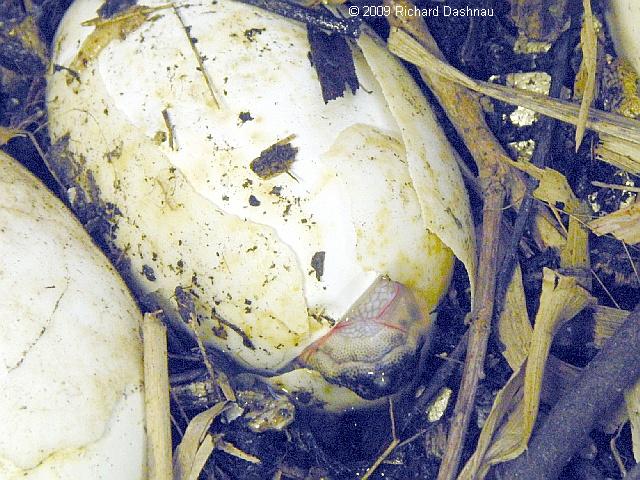 ---------------------------------------
---------------------------------------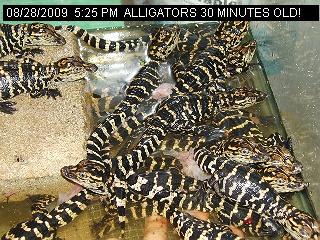
BABY
GATOR POKES ITS NOSE OUT
OF ITS OWN
BUSINESS
RICKUBISCAM SHOT
As
with
many unique natural events at the park, we try to use the opportunity
to
share something really unique with the people who visit the park. Few
people
get a chance to hold an actual American
Alligator. And, fewer still get
to HATCH one. There is nothing like the feeling of seeing the
little
head pop out of the egg, and watching that 8-inch long baby dragon
uncurl
as it comes out of the egg
and takes its first look at the world. By the
way, baby alligators don't "imprint". That is, they do not *ever*
recognize
humans as a parental figure--even if they are hatched by a human. Even
babies
we have kept for a year will still recognize an adult female alligator
when they are released and will chirp and swim towards her.
On her
part, the adult responds to the chirps and will become
immediately defensive
of the babies she has never seen before.
Most
of these newly-hatched will be released back to one of the females in
the
park (possibly the one they were borrowed from) within a few weeks.
Baby
alligators are near the bottom of the food
chain (even though the female
protects them through incubation and a few years after hatching). The
ones
we hatch have a good chance for those few weeks. We keep a few in the
nature
center
(to be released next year when we get new ones). A few others go
to some local educational facilities and parks.
Brazos Bend State Park The main page.
Brazos
Bend State Park Volunteer's Page The
volunteer's main page.
Go back to my main alligator page, Alligators
Go back to my home page, Welcome
to rickubis.com
Go
back to the RICKUBISCAM
page.
Go
back to the See
the World
page.